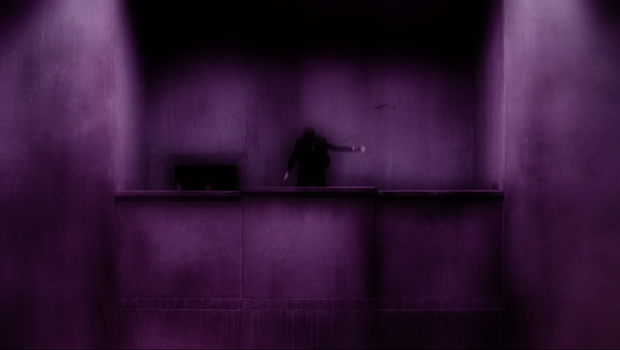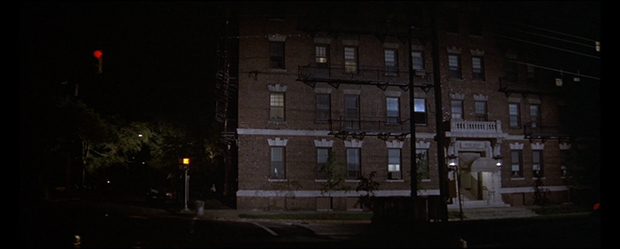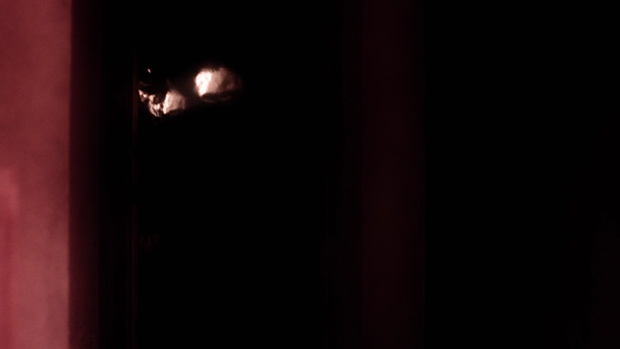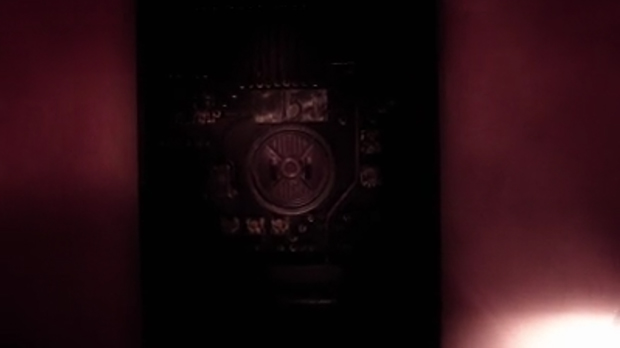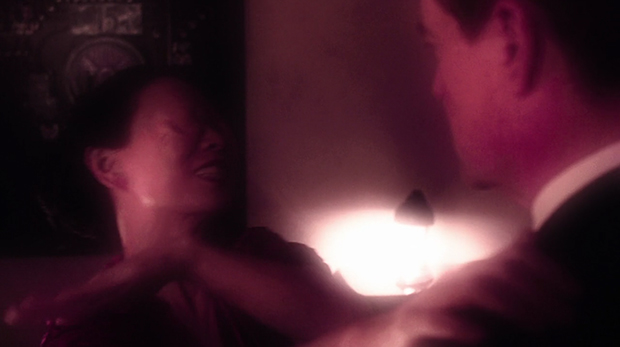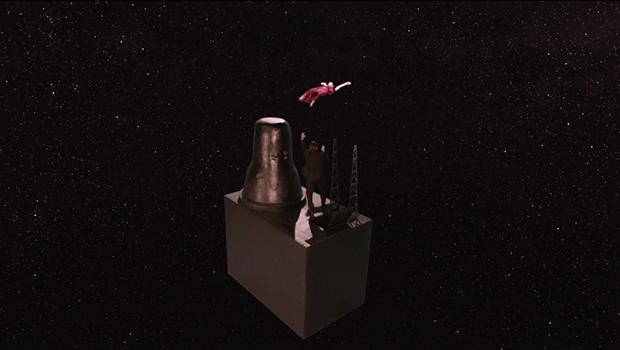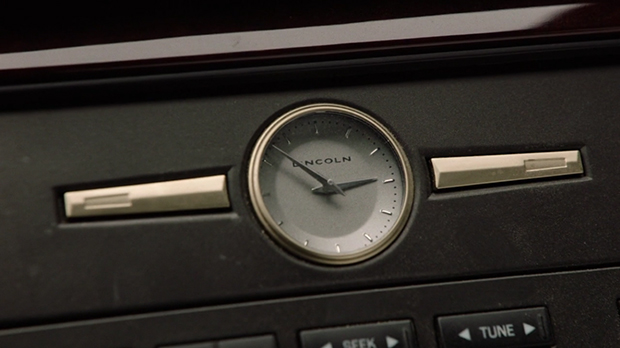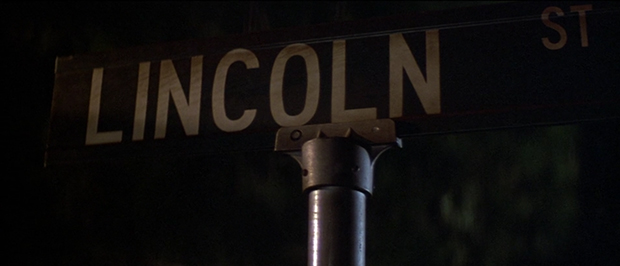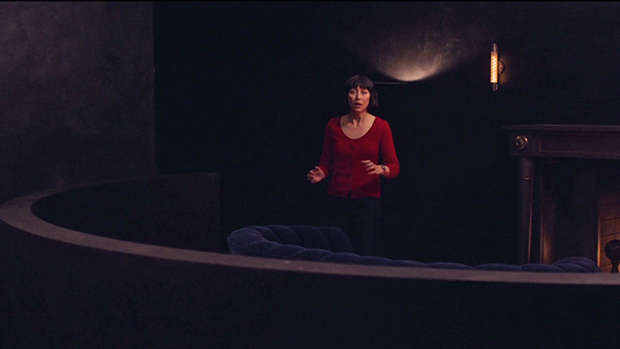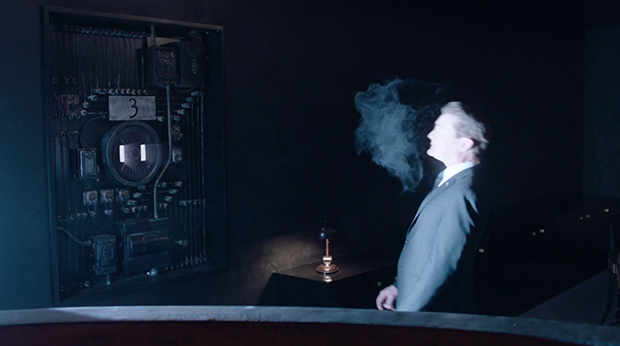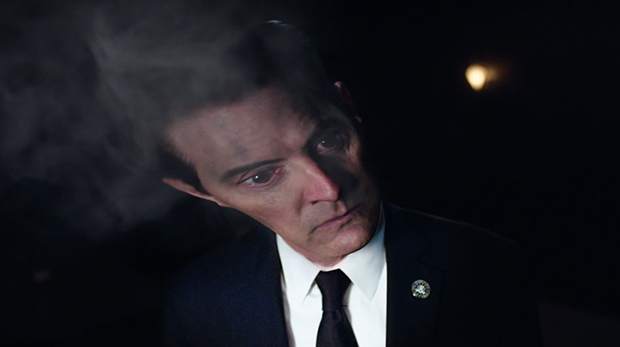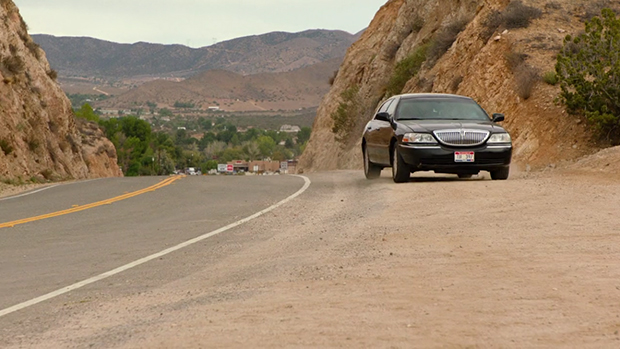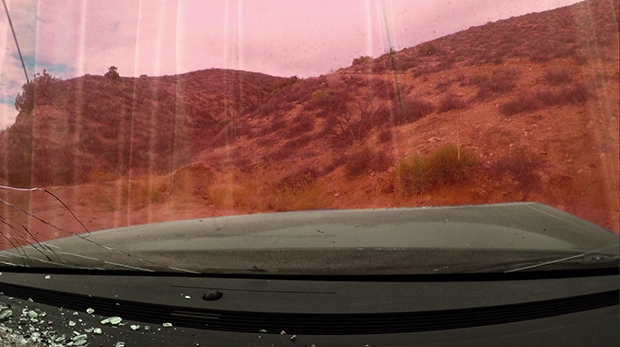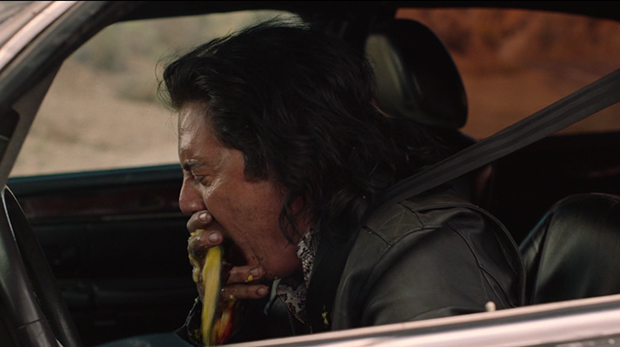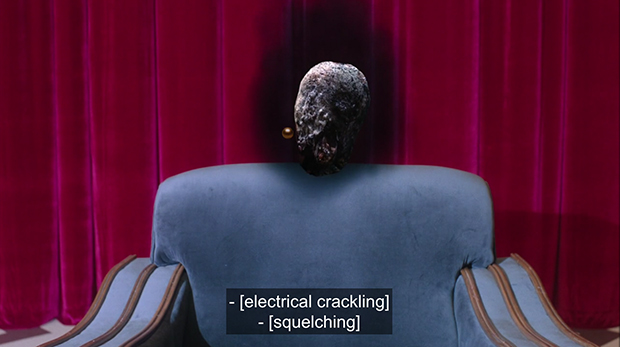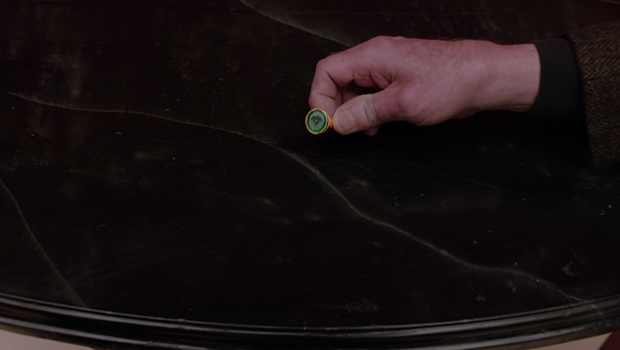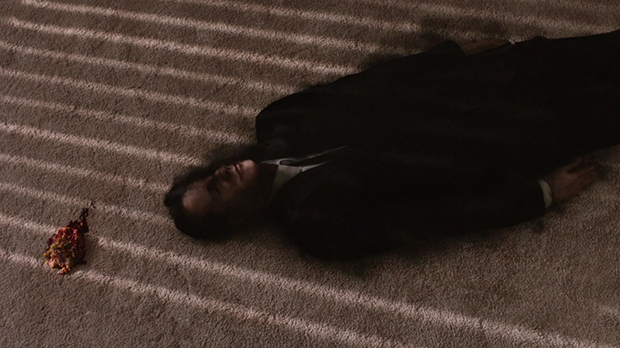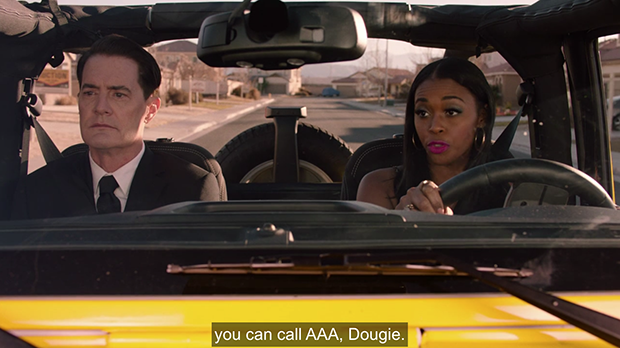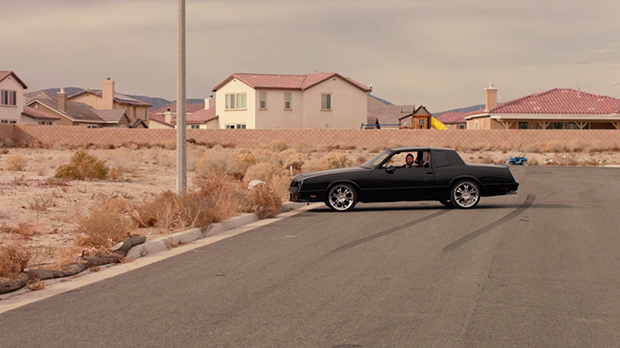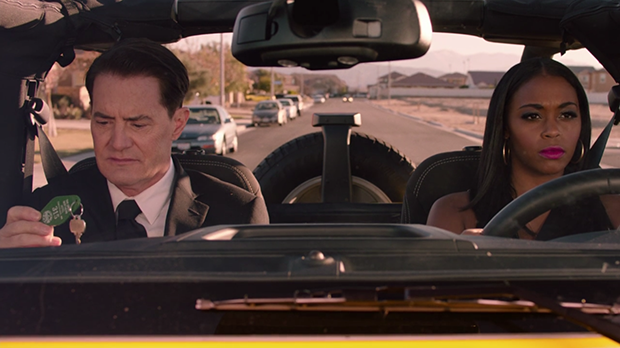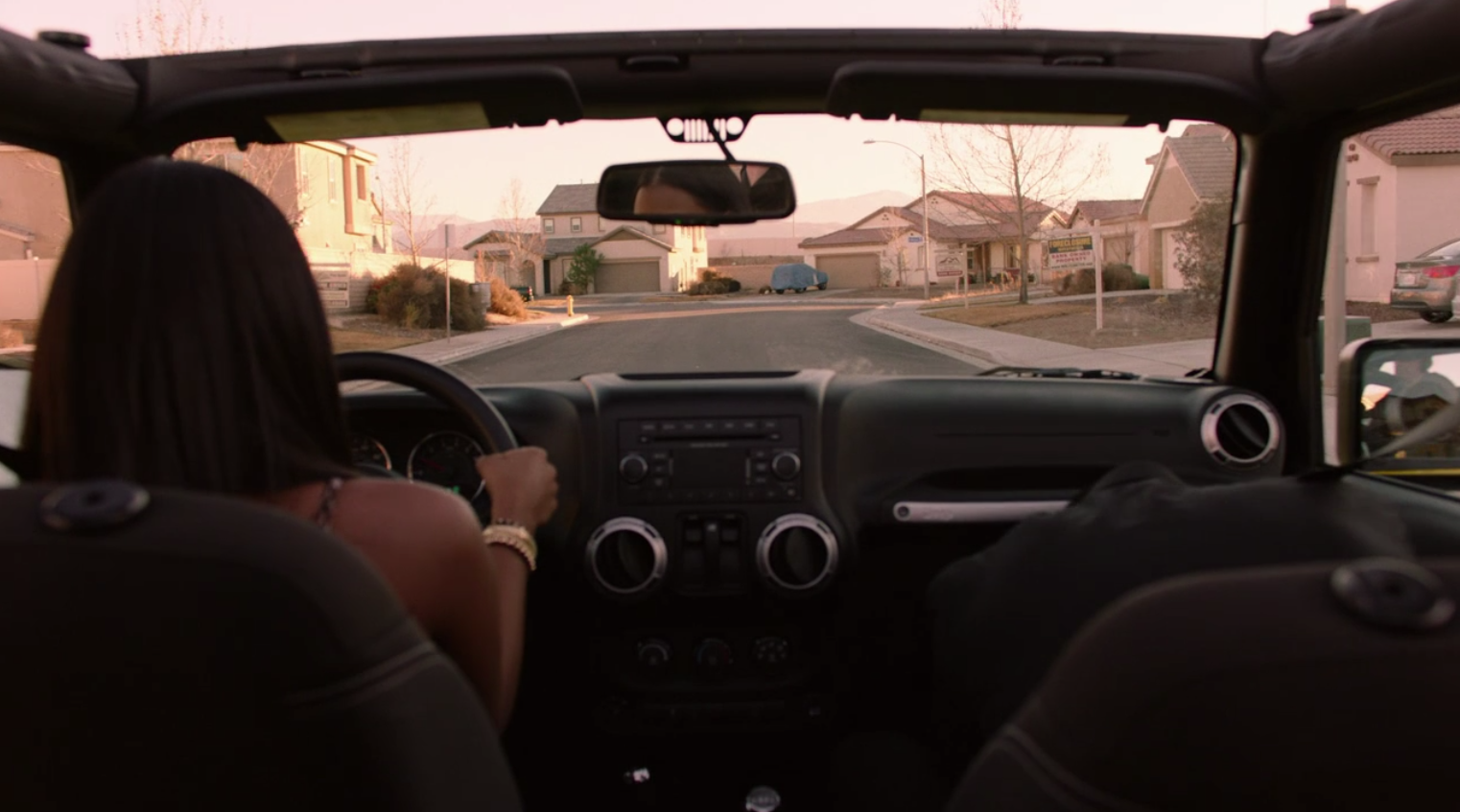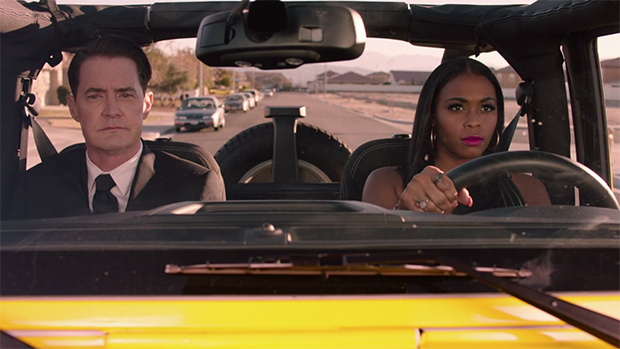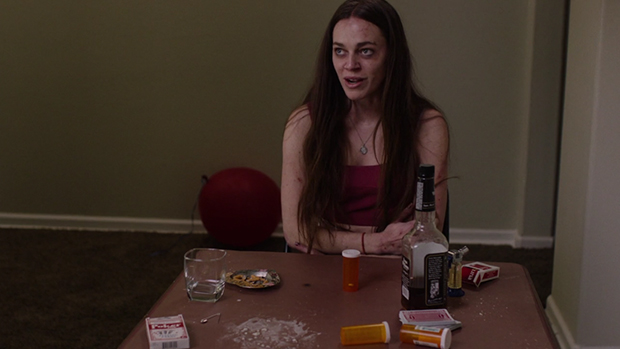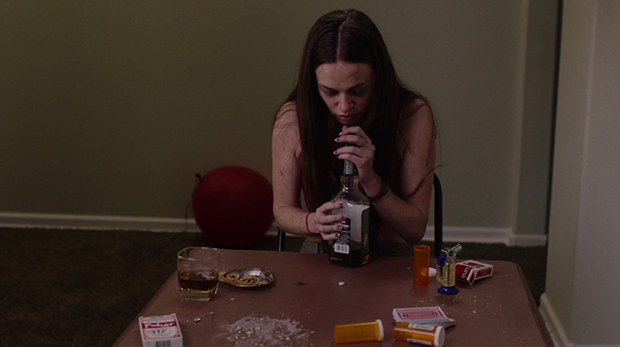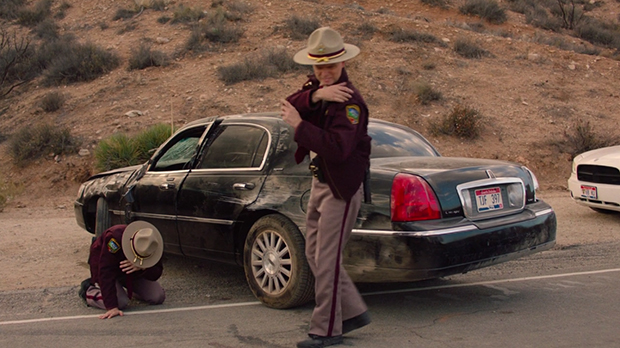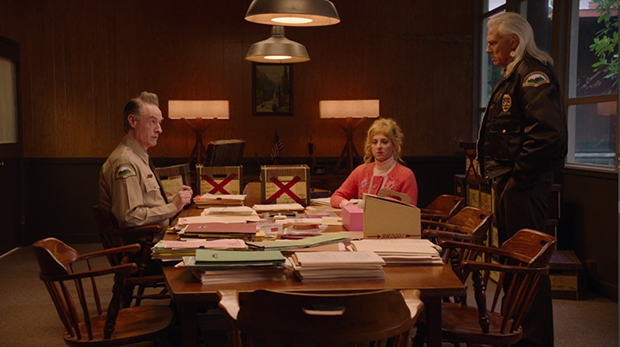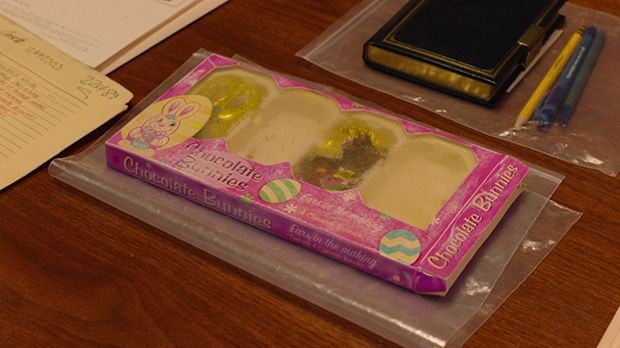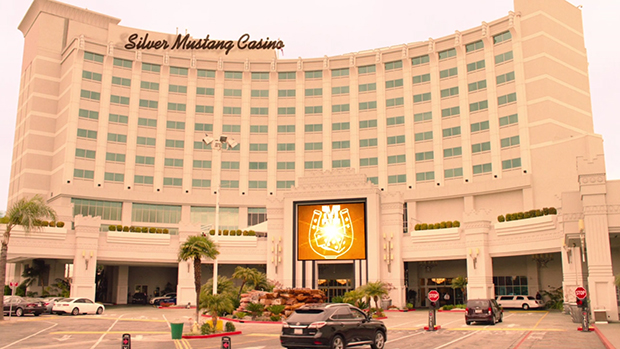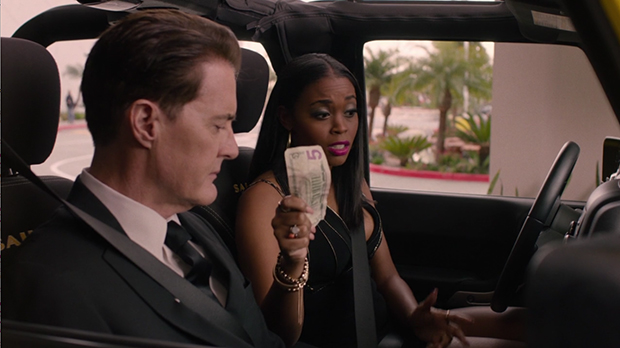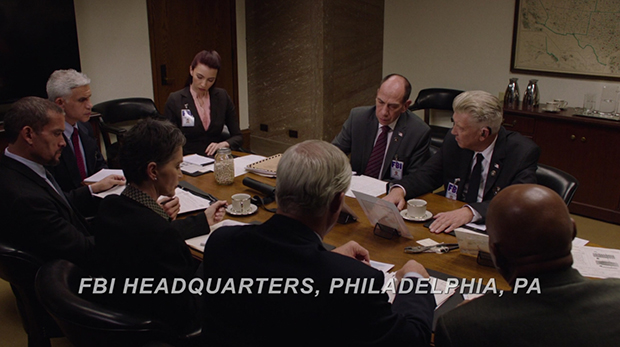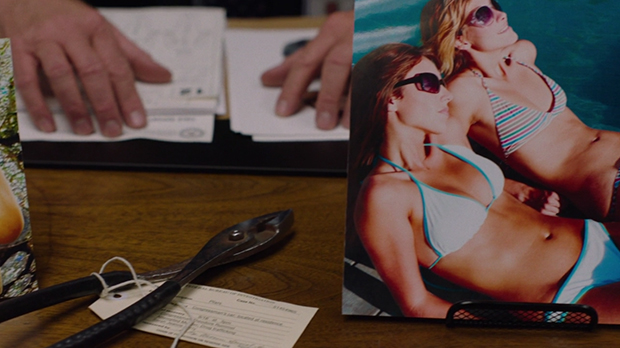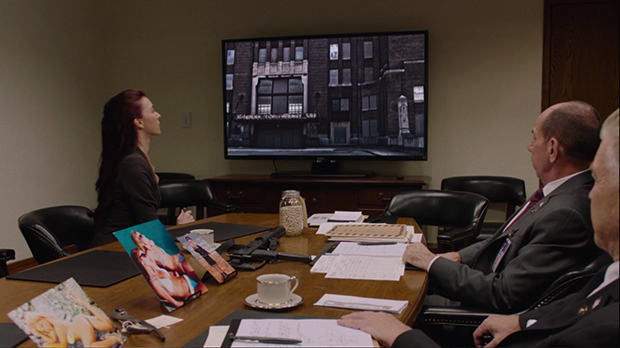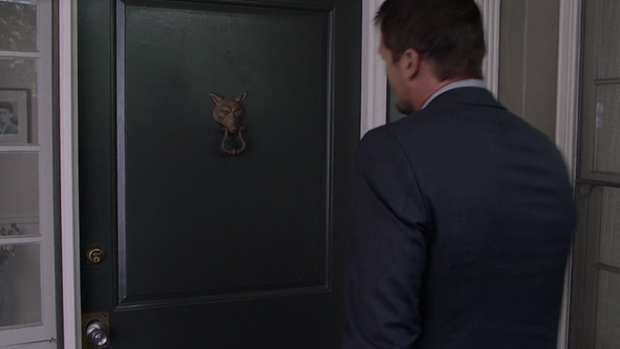TWIN PEAKS: THE RETURN

Go to Twin Peaks Table of Contents for a note on the analysis.
PART THREE
TOC and Supplemental Posts | Part 1 | Part 2 | Part 3 | Part 4 | Part 5 | Part 6 | Part 7 | Part 8 | Part 9 | Part 10 | Part 11 | Part 12 | Part 13 | Part 14 | Part 15 | Part 16 | Part 17 | Part 18 | Films Home
LINKS TO SECTIONS OF THE ANALYSIS ON THIS PAGE:
COOPER PASSES THROUGH AN ELECTRICAL OUTLET - A violet lotus world / The transforming of the viewer into an experiencer rather than only a witness / comparing the darkness above the balcony to the non-existent 7th floor in Blue Velvet / The mauve world and the woman in the red dress compared to Dorothy in her mauve apartment in Blue Velvet / The violet world, the mauve world, and Jacoby's eyeglasses / The relationship of the violet world to ??????? / A blind woman as "Non-existent Path" / The relationship of the woman falling off the "roof" to Dorothy in Blue Velvet / The Blue Rose on the table / On Ronette Pulaski and her relationship to fire / Transformation of energy and the switch of the outlet from 15 to 3 / The balance of 2?52 / 2:52, 2:53, Lincoln and Blue Velvet / 2:52, 2:53, time and the positive and negative principles of the mother.
COOPER IN, DOUGIE OUT - The missing drawer / The green ring / Manufactured / The green chair becomes a blue velvet chair / The missing FBI pin / The opening of the Red Room in proximity of the sycamore though not at Glastonbury Grove in Twin Peaks / Little Rock / Jade give two rides / The serendipity of Cooper-Dougie disappearing by virtue of the speed bump and his dropping of the key / Inherent being and the horse in Le San des Betes, and Eyes Without a Face
THE BLUE PILL - Reversal of 911 for 119 / Salty, crunchy / Black Label / The despair behind the smiling billboard faces of Rancho Rosa / Salt and alchemy and its relation ship to Dougie's combustion.
C TAKEN INTO CUSTODY
IT'S NOT ABOUT THE BUNNIES - The problem of knowing what is missing
JACOBY'S SHOVELS - From calling for gas masks in South Dakota, to Lucy dealing with a gas bubble twenty-five years ago, to Jacoby wearing a protective mask while painting his shovels, and the relationship to Cooper's and Albert's discussion on skrying the associative
CALL FOR HELP - You can go out now / Lincoln and the five dollars, the Lincoln car's clock, Lincoln Street / The silver Mustang and the pale horse / Meg Foster and They Live / The starry rug / Dougie-Cooper as the innocent fool
FBI HEADQUARTERS, PHILADELPHIA - The puzzle of the congressman's dilemma and clues as the identity of the killer / Tammy Preston as possibly a woman in one of the photos / Great northern white beans the the Great Northern Lodge / The drugged-out mother's broken lamp and Sammy and Tracey / Gordon Cole, Eraserhead, and Trinity / Gordon's deafness and word play / Kafka at the Hastings and in Cole's office.
THE ROADHOUSE
SOME NOTES ON THE ORIGIN OF DAVID LYNCH'S GARMONBOZIA (THE CREAMED CORN OF PAIN AND SUFFERING) AND ARM/MOTHER/TREE RELATIONSHIP IN
ERASERHEAD
STAB AT A TIMELINE
THE INTRO CREDITS
As in part two. See that part for description.
COOPER PASSES THROUGH AN ELECTRICAL OUTLET
A VIOLET LOTUS WORLD / THE TRANSFORMING OF THE VIEWER INTO AN EXPERIENCER RATHER THAN ONLY A WITNESS / COMPARING THE DARKNESS ABOVE THE BALCONY TO THE NON-EXISTENT 7th FLOOR IN BLUE VELVET / THE MAUVE WORLD AND THE WOMAN INTHE RED DRESS COMPARED TO DOROTHY IN HER MAUVE APARTMENT IN BLUE VELVET / THE VIOLET WORLD, THE MAUVE WORLD, AND JACOBY'S EYEGLASSES / THE RELATIONSHIP OF THE VIOLET WORLD TO ??????? / A BLIND WOMAN AS "NON-EXISTENT PATH" / THE RELATIONSHIP OF THE WOMAN FALLING OFF THE "ROOF" AND DOROTHY IN BLUE VELVET / THE BLUE ROSE ON THE TABLE / ON RONETTE PULASKI AND HER RELATIONSHIP TO FIRE / TRANSFORMATION OF ENERGY AND THE SWITCH OF THE OUTLET FROM 15 TO 3 / THE BALANCE OF 2:52 / 2:52, 2:53, LINCOLN AND BLUE VELVET / 2:52, 2:53, TIME AND THE POSITIVE AND NEGATIVE PRINCIPLES OF THE MOTHER
A good deal of this is without dialogue and I was going to
try to speed up my analysis by not including shot numbers but that's not working for me because I need the structure. However, there are so many quick shots that it would be difficult to list them, so don't look for strict accuracy in shot enumeration.
If you thought part two was trippy, it was just prepping you for this ride.
(1) The
opening is abrupt, continuing from part two with Cooper falling through
something that looks like starry space, face to us, (2) then away from us, (3) a
close-up of his face to us, (4) then away from us, (5) a close-up of his face to
us. (6) Then he sees blossoming before him, out of a violet mist, a
cloud. This cloud, at first, briefly appears to have a stem, which invites the impression of it being as a growing flower.
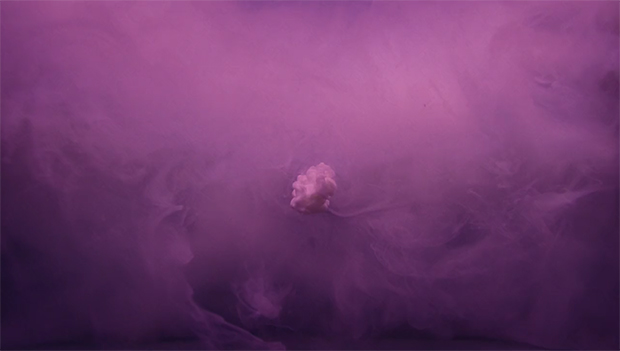
Lilac cloud and stem

Lilac cloud blossoming

Cooper
The cloud billows, growing toward Cooper as he falls toward it. (7) We see a close-up of his face and his flesh turning violet as it reflects this purple. (8) The cloud (9) and then Cooper again. (10, a quick block of quick shots) The cloud encompasses the screen as Cooper (the camera) enters it.
(11) The cloud and mist suddenly gone, in this violet world we see a balcony of what seems a large building composed of a cement-like or stony material. The wall of the balcony is composed of three great slabs of this material in uneven heights. We have only a medium-shot of the balcony, unable to see its environment, the whole building, as Cooper plummets down into it, disappearing behind the wall. The violent wind sounds that had accompanied his fall stop.
Cooper's journey through the white-flecked darkness (I hesitate to call it starry darkness due to the relationship to the particulates that swirl around Henry in Eraserhead, as I've described in part two), especially with his entry into the lilac cloud (I was immediately reminded me of a lotus blossom), has been bewildering and disorienting, partly because of the length of time afforded this journey. We are given an opportunity to ourselves become as presumably disoriented as Cooper, to begin to share in the experience rather than just briefly witnessing his fall. In part one I had discussed how our introduction to the glass box recalled staging elements of Blue Velvet that again sought to make the audience aware of voyeuristic witnessing versus experience via Jeffrey being pulled out of Dorothy's closet and into the action. We have the same happening here, increased audience immersion (at least with those who can concentrate on the scenes) due the amount of time afforded some scenes, which these days is very unusual in television, as well as film. Even decades ago there was the acceptance that audience attention spans had radically shortened, due commercials, and wouldn't tolerate long, contemplative shots or scenes. What was wanted was constant action, change, to keep the audience absorbed. I was confronting this even as a playwright, back in the late 1980s and in the 1990s, with directors feeling they needed to change theater to accommodate the shortened attention span. Instead, Lynch/Frost are taking pains to accustom the viewer to lengthier shots and scenes. How things were plotted in the first two parts have prepared the viewer for part three.
To make a comparison with Kubrick, his pacing in 2001, which might seem to some overdrawn, helped to prepare the viewer for the extended journey through the infinite.
(12) As an absurd reward for the viewer staying tuned in to Cooper's journey, the manner in which he plummets suddenly into this balcony and disappears is hilarious.
That's gotta hurt. Except it doesn't. However the physical body works in this dimension, it's nothing like in ours.
(13) Looking out from the balcony, instead of seeing the dark white-flecked sky, within this lilac cloud, we have a view of a violet sky and sea.
(14) We see the balcony from below, what is above it receding into blackness.
This blackness may remind of Blue Velvet. Jeffrey goes to the detective's house to ask about the ear he had found. The detective tells him he can't discuss it and instructs Jeffrey he's not to talk about this with anyone. As Jeffry leaves, Sandy, the detective's daughter, exits from the deep dark night to tell Jeffrey about a person of interest, Dorothy Vallens. She informs him Dorothy lives on the 7th floor of an apartment building close to him. That Dorothy lives on the 7th floor is stressed several times in the film. The thing is, the building used for exterior shots was the Carolina Apartments at 420 Market Street in Wilmington NC and has no 7th floor. It only has six. Lynch usually only shows us the first 3 floors of the apartment building, those above ascending into absolute darkness. In one day shot he shows the whole building but the upper floors are partly obscured by a tree. We can still tell, despite the tree, that the building has six floors, but one would have to be paying close attention to catch this. Dorothy's apartment on the non-existent 7th floor, as it turns out, is surrounded on all sides by halls and so could have no windows onto the outer world. I discuss this extensively in my analysis on Blue Velvet.
But to return to this new, violet-purple world that
greets and encompasses Cooper by way of a violet cloud, the cloud blossoming out of a sort
of long stem. First, we might examine the effect of this new
and unexpected world on the viewer. They have no bearings by which to comprehend its
place in Cooper's universe or their own, even though the
Twin Peaks audience is used to the incomprehensibility of the Red
Room. They have, however, become used to the Red Room, and the Red Room
has also had, from its introduction on, associations with the world of
Twin Peaks that provided anchors for the viewer, despite the
incomprehensibility of much that happens in the Red Room. Now, there are no
anchors. There will be no Laura Palmer at this place. There will be no Gerard. The viewer is dissociated from anything that would provide
definition or compass for this place. They will be
asking, "Okay, where am I? What am I doing here?" Cooper's confusion
will be as their own. In
cinema situations such as this, the viewer has become a participant,
like the character.
Personally, considering the hues and the way that the cloud blossoms out
of a stem, as I've previously noted, I'm inclined to look to the lotus flower, which grows up out
of muddy water toward enlightenment, the stem removing one from
attachment and desire. The lotus is said to symbolize fortune, purification,
faithfulness, the purple lotus also referring to the
mystical. Another reason I'm inclined to look upon this violet cloud world, in which we find a great sea, as inspired by
the lotus blossom, is due what I have written at the end of part two in
respect of Lynch introducing "non-existence" prior Cooper's fall into
the waters, and thus perhaps the Buddhist concept of emptiness.
We recognize as sea not only that which is not the sea; we recognize as the sea that which is the sea.
Flatbedsutra unwinds the concept of this sea as following:
"Though we (the present subject of this body-mind here and now) do not know what it (the Great Sea) is," it is at this present "moment" the words "myriad existence." Every particular dharma we encounter (experience) is a "momentary misperception" (partial perception, or experience) of "every dharma" that actually constitutes the totality of existence time, Buddha (all things) -- to express it differently, every particular dharma we encounter (experience) is an "accurate perception" of a particular or momentary instance of Buddha (the Great Sea).
(15) We view the balcony and Cooper rising and looking out over the placid sea. (16) We have a medium close-up of him. (17) We see the sea from behind Cooper, which is a particularly enigmatic shot, reminiscent of a Magritte painting. (18) A med close-up of Cooper looking at the sea. (19) Then the sea again. (20) Cooper again. (21) A long shot of Cooper on the balcony. He has noticed a door or window to screen left. (22) A view of him approaching the double-door of the window. (23) We see him from inside a room colored with mauve light, he looking in through the window. (24) From outside we watch him open the window. (25) From inside we watch him enter.
Absurdly, though I never wonder what entity has done the interior design for The Red Room, as Cooper climbs through the window the thought occurs to me, "Who built this?" There is something different about the environment as far as a sense of intention, or I wouldn't feel this way. But of course they instead need to be examined symbolically rather than literally.
We should compare this mauve room, in which we will find a woman in a long red dress, to Dorothy in her long red dressing gown in her mauve apartment in Blue Velvet. The apartment is on a "non-existent" 7th floor, and is bound on all sides by halls so there are no windows. We see two windows only there, and outside of one is brick, and the other window is so milky-opaque we only glimpse shadows outside it. Jeffrey's plan was to enter the apartment as the bug man, open a window, and return by it later in order to spy on her. This didn't happen, he had to use keys, and a reason it didn't happen is because there are no windows onto the outside world there. When Dorothy was not in her blue velvet gown, she was dressed in a short-sleeved long, red dressing gown that much resembles the gown worn by the woman we will encounter here. This woman is "blind" as her eyes are covered by flesh, and this also reminds of Dorothy in the otherworldly realm of her apartment that has no real windows.
This burgundy red that the woman wears is much the same color of the robe that Sarah Palmer had been wearing in episode two.
Jeffrey Beaumont may not have been able to climb into Dorothy's apartment through a window, nor could he use an elevator that would take him to the seventh floor as it was out of service. He had to use stairs. But Cooper is in transition, trying to return to our everyday world from the Red Room, and it seems has become a Jeffrey who is now able to climb in through the window.
If one takes a look at Phillip Jeffrie's peculiar visit to the FBI office on that February day (a day which Cooper had dreamt about and was anxious about), the FBI office is on the 7th floor, and outside the windows all the surrounding buildings have a violet tint. Toward the end of that scene, Gordon calls out, "What, am I alone in here?", Jeffries disappears, and the front desk says that he was never there.
Before continuing, let's reflect again upon Jacoby's eyeglasses, which I've written about in part two. Also, how Jacoby viewed Nadine's blinding. The red polarizing lens on the right eye is intended to surpress left hemisphere logic, while the blue on the left eye is intended to surpress right hemisphere intuition, and thus working together in a world of purple light one is supposedly able to better balance the intuitive and logical and have a better grasp on reality. If we apply that to what is happening here, Cooper, with his entry into the violet world, has entered a more balanced area of perception. But when he steps inside the building, it is into a mauve room that perhaps suggests instead viewing only with the red lens over the right eye.
Two women, Phyllis and Ruth, have been killed with a bullet through the left eye. Nadine was not killed, but simply deprived of that eye. This means those three women (if Phyllis and Ruth had lived), if they did wear Jacoby's glasses, would only be viewing through a red lens suppressing left hemisphere logic. Or it may be we are intended simply to think of this also as a purple world because of its exterior setting.
(26) We see a woman in a red dress as we hear Cooper's feet hit the floor. Her eyes are covered with flesh. (27) Return to a view of Cooper now in the room as he closes the window and turns to walk further into the room. (28) Another view of the woman. (29) Cooper sees her. (30) The woman, who is seated on a couch. (31) The briefest glimpse of the full room, (32) then of Cooper, (33) then a long side-view of the woman, (34) then a fireplace. The fire flames up in the fireplace and there appears to be dark fire within it. (35) Cooper again and he glitches as he moves forward, as if becoming stuck and moving back in time, and forward again. This happens continually throughout these shots. (36) The fireplace. (37) Cooper. (38) Returning to the woman we see a semi-circular half-wall behind the couch upon which she is seated, the light of the fireplace before her flickering her face. We briefly see that the design on
the floor is the same as was observed at the feet of ??????? in the
intro and epilogue of part one. We saw very little of ???????'s
environment in part one, but with even the little we saw of that black-and-white world this room
appears to be otherwise quite different, the floor right now the only
connecting element.
In this fiction we have Cooper within a prepared space. Like the glass box, which was there for him to fall upon, the balcony was waiting to receive him, and there was a portal by which he might enter the building.
The stuttering-glitchy movements, as if moving around in time, might recall how the glass box functioned with Cooper inside it, replicating numerous times, then some of those replications being undone, then replicating ten times and Cooper popping out of it. There may be a relationship had. The editing is very similar to the several close-up shots of the lions attacking the buffalo in Sarah Palmer's household in part two, and this time they concern a woman whose fase has multiple scars. It's interesting, how normal she appears despite the scars and her eyes being covered over with flesh. She communicates not as a grotesque, but as an unknown individual, this woman in red.
We
will learn from the credits that the blind woman's name is Naido (Nae
Yuuki), which may be Japanese for "Ruler's private property", composed
of ideograms for inside/within/house/home and money/repository. The
ideogram for "inside" shows a person in an incomplete square, one side
open. It can also be understood as Emperor's privy purse. The manner in
which the ideogram for Nai is formed, a person's form half in and half
out of the house, it reminds a little of Cooper's dramatic fall onto the
balcony.
However, nai can also mean "not". As a suffix
it is negation. When not used as a suffix, it means "nonexistent". And
The Tree as The Arm had, as Cooper plunged into the waters, cried out,
"Nonexistent!" Do might then mean path or way of life. The
woman then represents the nonexistent path. I am going with Naido referring then to the Nonexistent Path over the other possible interpretation.
Some may connect Naido with Josie Packard from the original series, but
Josie Packard was Chinese while Nai is Japanese. Yet, it would be easy to see why the
association is made due what happened with Josie after her death. In part two I give some of the history of Josie and
how, upon her death, her spirit appeared to have been absorbed into the
wood of a nearby dresser. We briefly saw her face within the wood, her eyes
appearing to be sealed shut. Later, it seemed she became an inhabitant of the materials of the lodge, Pete Martell saying he saw her in the wood above a fireplace.
If Josie is being referred to, we should consider that BOB had appeared
to Cooper, with Josie's death, taunting, asking, "What happened to
Josie?" Does he mean what made her the person she was? Does he mean what
caused her to suddenly die? Does he mean what happened to her soul?
The woman who plays Naido (Nae Yuuki) appeared in Inland Empire as a
homeless woman. In the film, Sue (Laura Dern) sees her own doppelganger and
then is stabbed. She falls down beside some homeless people, including
Nae Yuuki. Actually, Sue looks more like she plumets there rather than
simply collapsing, which seems to correspond with Cooper's falling into the balcony. As Sue lays dying, rather than calling for help for Sue, the
homeless woman played by Nae discusses with another how to get a bus for
Pomona. She also related a tale of a prostitute friend of hers who looks
just like a movie star when she wears a blonde wig.
As Cooper approaches the blind woman, she turning to him, they seem to
keep slipping backwards in time and events repeating. We hear an
electronic hum. (39) Cooper. (40) We see her as if becoming aware of him for the first time again. She raises a hand toward him. (41) He approaches and they grasp hands. (42) Return to a closer shot of the woman as she takes his hands. (43) Then a side shot of them both. (44) Then we have an establishing shot of the room from beyond the half-circle of the wall that encloses the couch. We see the fireplace, the two sconce-style lamps to either side of the fireplace, the arched vault of the ceiling, and Cooper standing before the sofa, all of this separated from us by the half-circular wall. (45) Again, a medium shot of the woman taking his hands again. (46) Then a side view of them. (47) And a long shot. Cooper asks her, "Where is this?
Where are we?" (48) In a side view, she pulls him to her screen right. (49) A closer view as she pulls him down to the couch and feels his face. (50) A close-up of this. (51) A side view. (52) Another close-up. (53) A side view. (54) A close-up. (And I am about to give up giving the different shots as they become more rapid.) She
speaks but what she is saying are choppy, unintelligible, breathy
sounds. (55, a block of shots) A side view. More quick and choppy shots of this while while there begins a loud pounding and Cooper looks over (56) to what seems to
be a door with two holes torn in it. We are only ever shown a close-up
of this dark plane with two holes in it, and it is simply assumed to be
a door.
We need to question what is the purpose of the two
holes. What has made them? Everything else in this place of few details
is slick perfection while these are torn, jagged.The two holes are made
so that they can almost appear to be bullet holes, which is a peculiar
detail in this alternate reality. What is the source of the bright white
light that shines through the holes? We had been shown a bright white light behind Laura Palmer's face but that was connected with life, we felt it to be positive, while this feels decidedly malevolent, something banging and trying to get in. We are reminded of the Experiment in the glass box and what had happened when it burst out of it.
(57, a block of shots) The woman raises a finger to her lips, urging quiet, convincing him to be quiet, that he is not to approach this knocking. We
see more clearly on the side of her face what are either scars or stitches that fasten her
eyes shut. Very quick, choppy shots of her and the holes in the door. (58) A medium-long shot of them. (59) A close-up. (60) The door. (61) Side shot of them. (62) The door. (63) Side shot. (64) The door.
(65, a block of shots) Cooper now sees a huge, very industrial looking outlet in a wall behind them. The pounding continues and then beyond the half-circle wall a desk light
comes on next to the #15 outlet, this accompanied by a higher-pitched
hum. (66) This repeats again, Cooper noticing the outlet and the desk light again coming on. (67, block of shots) Yet another repetition of this sequence.
(68, a block of shots) Drawn to the outlet, though she tries to stop him, Cooper goes to look at it. As he approaches it, the outlet seems to repel him. She follows and places herself between him and the outlet. She mimes dramatic, violent slaps to keep him from approaching it. Considering that Cooper has just come from the glass box, where we have seen the Experiment kill Tracey and Sam, the violence of her slapping motions may signify this, and that the murders are happening even now.
Facing the rear of the room, away from the sofa and fireplace, the outlet is on the screen-left wall. She leads him to a door at the rear of the room on screen-right, down a short corridor. He follows her through it and
up a metal wall ladder through a ceiling hatch.
The quick and choppy shots end with their climbing up out of the mauve room, so I'm going to try enumerating the shots again, just because it helps to provide structure here.
(69) They climb out on top of a metal box that is much smaller than
the area out of which they emerge, and though we would expect the purple
sea instead there is only the white-flecked sky. (70) She seems to try to explain
something to him as she approaches a large metal dome on the box, (71) but he shakes his head to show he doesn't understand her. (72) She continues trying to explain. (73) Cooper. (74) She grasps a lever
on the dome, (75) faces Cooper, (76) a shot of him continuing to watch her, (77) and she pulls the lever down. Still touching the dome she crackles with
electricity. (78) Helpless, Cooper watches. (79) She continues being shocked. (80) Cooper watching. (81) Shocking of the woman. (82) Cooper. (83) She is finally shocked off the box, (84) Cooper watching as (85) she falls away into the
"starry" sky. (86) Cooper. (87) The woman disappears. (88) Cooper. (89) The "starry" sky.
We see how when she pulled the lever, the glow that had infused the scene stops.
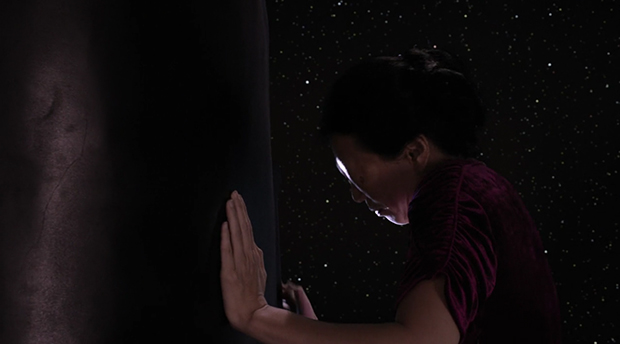
The glow ceases with the pull of the
lever
We are reminded of the horrifying manner in which Laura
was swept from the Red Room. We might worry that this woman is fated now
to fall forever through space, but it is a senseless expectation. Cooper
fell through "space" into a lilac cloud and into this place. We can have
no conception at all of what will happen to this woman, which is to
assume that she is a "woman" rather than simply having the appearance of
a woman. What we do feel is that she has likely protected Cooper.
In Blue Velvet, Dorothy was effectively being held hostage in her life by Frank, he having kidnapped her husband and child and through this forcing her to do things. In the screenplay, she said she wanted to die. Not in the film, but in the screenplay (and deleted scenes), she led Jeffrey to the roof of the apartment building. That rooftop scene is actually reminiscent of this one in feel though what happens is different. She had let fall one of her red shoes from the roof, then had played at balancing on the edge. Jeffrey saved her from falling. In the screenplay, he later dreamt of her red shoe falling from the roof and becoming her screaming mouth. Something of Dorothy can be found in this scene with Naido seemingly sacrificing herself in flipping that switch and cutting off the mauve light. Dorothy had spoken of her dying as a self-sacrifice, as if she was the reason men were crazy and abused her, and if she died it would make them free. I'm not saying we have the same thing with Naido, just that the rooftop scene reminds of this.
(90) A medium close-up of Cooper with the white-flecked sky behind him. A metallic creaking begins. Though we've seen the woman fall a great distance, we begin to have the feeling of the environment as being a hologram construct. (91) Looking down into deep space below the box, (92) Cooper is then shocked when (93) the face of Major Garland Briggs, gigantic, semi-transparent, passes by. (94) Cooper watches. (95) The face of Major Briggs. (96) Cooper. (97) Major Briggs speaks.
GARLAND BRIGGS: Blue rose.
If the violence the woman pantomimed in the mauve room was coincident with and intended to show the violence then happening to Sam and Tracey, then it's to be wondered if, in this timeline, Garland Briggs has just been killed, as well as Ruth Davenport.
Blue Rose was a mysterious code for FBI investigations under
Gordon Cole that were seen as possibly associated but the name and original
parameters never defined, other than that the paranormal or inexplicable
seemed to be a component.
It seems that Briggs' head can see Cooper as it floats by and is telling him this has to do with the Blue Rose cases?
(98) Cooper. (99) Briggs' gigantic face disappears from sight.
While Cooper has this confrontation with the face of Major Briggs, the black and white of his FBI page appears to invert so that it is instead white with black print. I don't know if it is just the light. The badge returns to normal again after the face passes away.
(100) Cooper on the box. (101) He looks around. (102) A long shot of him from above. (103) Shot from below. Stunned, bewildered, alone now, Cooper climbs back down the ladder
into the box and closes the hatch. (104) Inside, he descends the ladder to the floor. He exits into the short corridor that leads into the main room and is greeted with a new view. The room is simply dark, no longer saturated in mauve tones, the fire in the fireplace is now a normal fire, and we see another woman seated beyond the half-wall. (105) Cooper. (106) Against the rear wall opposite the fireplace, there is now a dining table and upon it is a vase holding a luminescent blue rose. The super-sized wall outlet is still there, but now reads 3 rather than 15. (107) Cooper. (108) A close-up of the outlet. (109) Cooper enters the room. (110) The woman from the rear. (111) Cooper. (112) The woman, in a red shirt, with a black pageboy haircut, seated before the fire. She slowly turns and
looks at him as a low throbbing boom begins. (113) Cooper. (114) She slowly looks away. (115) Cooper.
The other woman was curious and expressive. She immediately attempted to communicate with him. This woman reacts to Cooper's presence without expression.
None of these
surreal happenings can possibly make any sense to the viewer, they will
only gather that there was some threat from which the blind woman seemed to be
possibly protecting Cooper, and then they are given the anchor of Major
Briggs and the Blue Rose. Those are familiar things. This peculiar box
in space is not a familiar thing and makes no sense. Then when Cooper
climbs back down into the room, its light has changed and there is yet
another unfamiliar woman there. The viewer is in a continual state of
disorientation.
To review what has happened, Cooper enters the violet blossom in which he finds another seeming universe with a purplish ocean. He enters a building where in a red-tinted environment he meets a blinded woman who is unable communicate with him except by gestures, he not understanding her speech. There is some interference/playing with with time and scenes often repeat three times. A banging on a door presents danger. The woman prevents him from approaching the #15 outlet, expressing it as being dangerous. She takes him outside the environment, by a different route from the window, so that they enter not the "outside" with the ocean but the "outside" that is white-flecked space. She switches off a seeming generator and is shocked into space. The red light and glow ceases. Briggs appears and says, "Blue rose", perhaps having just been murdered. Cooper then enters again the room and there is now a blue rose on a table and a new woman waiting there. The choppy time interference, things repeating, has stopped.
The blue rose on the table is interesting for as far as we know the blue rose is simply a name for these paranormal cases, but now it is a physical (well, kind of) reality. We see it.
If we think back to Sam and the glass box room in NY we may remember that on the first day he changed and archived an SD card in camera 3 before Tracey arrived with their lattes. The second day, he was changing an SD card in an opposite camera, then was shown to be changing the SD card in the #3 camera, and then finished out changing the card in the opposite camera. This was a kind of glitch, his being on one side, then over at the #3 camera, then back on the other side again. That day he heard the elevator arrive with Tracey but the security guard didn't call him to meet her. There would possibly seem to be some correspondance between that camera and these outlets, in as much as there was orientation confusion with the cameras, and Cooper descended back into the room to find the outlet has changed from 15 to 3.
Is this woman possibly the same one who was formerly in the room? Though she appeared to have fallen, has she only assumed another appearance, just as there have been other changes?
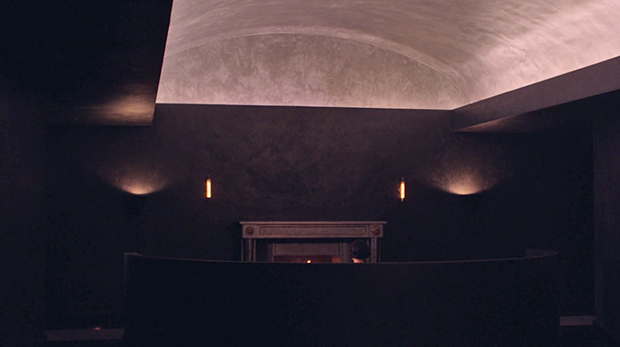
The vaulted ceiling and fireplace
(lightened)
(116) The woman slowly raises her arm. (117) Cooper. (118) She looks at her watch, which reads 2:52. (119) A desk light comes on by the #3 outlet.
The viewer is given another anchor. The Tree as the Arm
had told Cooper, "2-5-3. Time and time again. BOB, BOB, BOB. Go now! Go
now!" The watch that reads 2:52, advancing toward 2:53, connects to
this. There was the mystery of 2-5-3 and that is now being answered for
the viewer. We realize the switch between Cooper and the doppelganger
must happen at 2:53.
The watch also seems to read that it is
Saturday (SA) the first. Or does it refer
to Saturn, SA being the abbreviation for Saturn? The lore is that it's
when Jupiter and Saturn meet that the Red Room opens a physical entry to
the Black Lodge.
Looking at how the watch reads out 2:52 digitally, I'm not so confident that 2:53 has as much significance as 2:52, for the 5 is simply 2 reversed. There seems a state of tenuous balance at this point which will be lost as time pushes on to 2:53.
(120) Cooper notices the desk lamp. (121) The outlet and desk lamp. (122) Cooper. (123) The woman. (124) Cooper. (125) Zoom in on the outlet (126) then cut to Mr. C's car going down the same
highway we had seen in part two, Monday. He passes a crossing sign of a
man on a horse, which reminds of the pale horse Cooper had seen in part two after Laura was snatched away screaming, before Gerard asked him again,
"Is it future or is it past?", and he was asked by The Tree as the Arm if he
remembered his doppelganger.
(127) A shot of the doppelganger in the car is accompanied by the
intense hum. He seems to be having problems focusing his eyes, (128) looking
at the clock that reads Lincoln, 2:52.
The clock reads Lincoln because he is driving a Lincoln. However, if we go back to Blue Velvet, the night that Jeffrey goes out to take a walk (that will lead him to the detective's, and from there, via Sandy, to the apartment building of Dorothy Vallens) as he announces to his mother and great aunt his intention of taking a walk, his great aunt sits forward and asks him if he will be going down to Lincoln Street, her tone decidedly warning that one is not to go down by Lincoln Street as that is where bad things happen, where the wrong elements of society live. No, he says he's going nowhere near there. Then, at the detective's, he meets Sandy who tells him about Dorothy and leads him to Dorothy's apartment building. And we see that Dorothy lives on Lincoln.
(129) As Mr. C attempts to keep his eyes open (130) we are shown an
electrical socket, circled with green, in the car. (131) It begins to
electrically throb. (132) Cut back to Cooper who approaches the (133) sparking #3
outlet. (134) The woman in the red shirt rises. (135) Cooper. (136) The outlet. (137) Cooper is attracted head first toward the outlet, leaning into it (138) and is shocked back. (139) The woman speaks in Lynchian
backwards speech.
AMERICAN GIRL: When you get there, you will already
be there.
The woman is identified in the credits as
American Girl, played by Phoebe Augustine. Phoebe played Ronette
Pulaski in the original series. She was with Laura on the night
that Laura had died. Ronette had, however, survived. She had seen an angel, found her binding ropes on her wrists cut, had been beaten savagely by Leland/BOB, was both pushed out of the train car by Leland and pulled out of it by Gerard, and was left for dead. As far as I'm
aware, she was the last civilian who spoke with Cooper before his going
to Glastonbury Grove to enter the Red Room in the final episode of
season two. Margaret had arrived at the sheriff's department with a
bottle of oil that her husband had said was from the entrance to a gateway.
Hawk had then brought Ronette in and she identified the liquid, which had
the smell of scorched engine oil, as the same she'd smelled the
night of Laura's death. As best as I can reason, that is why she is here
as Cooper re-enters the "real" world. She was part of the transition out process and is part of the transition in.
Why would she be identified as American? A girl, when she is a woman?
Perhaps it's imagined this would ethnically distinguish her from Naida.
But that doesn't really work for me as, for instance, if Naida is not an otherworldly entity she could be American.
For this I think we need to look back to part one.
In part one we had the transition from the "bad girl" of Tracey to Beverly who was the "woman", not a girl, to be treated with respect. Then with the first
appearance of Mr. C., he was driving down a dark night road as the Muddy
Magnolias' "American Woman" played, the music dramatically slowed down
so that it sounded like a a man singing. This was the scene in which Mr.
C went to Buella's (who also had black hair cut in a pageboy, though a longer one), disabled the guard there, and picked up Ray and Darya.
We may also need to consider the
movie Magnolia in which different seemingly unconnected
characters are bound by having intersected with a street named Magnolia.
However, there's more to it than that. Paul Thomas Anderson, questioned
about the name Magnolia and myth-building, said: I don't know if you've heard of the
Magonia, but the Magonia is a mythical place above the firmament where a
ship will get lost at sea, and it'll go hang out in the Magonia, and
then 20 years from now an anchor will fall from the sky on like a barn
in Oslo or something like that, and they'll say, `Well, it came from the
Magonia. That old ship was hanging up there, and its anchor
fell.'
The inhabitants of Magoina were said to work
with tempest-raisers in magically rousing storms, and carrying crops
from earth up into their ships. Via Jacques Vallee, these ships became
linked to UFO mythology.
Major Briggs considered himself an
abductee.
There seems a comparison might be made between the lost
of Magonia, Cooper having disappeared into the Red Room, and the fact
he is about to reappear twenty-five years later. When the Red Room floor
opens, he falls through the sky that at first is as water.
As for Ronette Pulaski, I find it interesting that a pulaski is actually the name of a firefighting tool that is an axe on one side and an adze on the other side. It is like a revision of the labrys or double axe, so that one of the axes is twisted sideways.
Is that a reason why Pulaski is here? Consider that her name is that of a tool used for making firebreaks in firefighting. When Pulaski identified the oil, it was oil that had been supplied by Margaret's logger and firefighting husband, Samson "Sam" Lanterman, who had been killed in a sudden wildfire on the day they were married. Coincidentally, Samson is also the name of an axe. Consider also that the American Girl, Pulaski, sits before a fireplace.
Each time Cooper approaches the outlet, he is shocked back by it.
(140) Cooper. (141) The outlet. (142) Cooper approaches the outlet again and is again shocked back. (143) The smoking outlet. (144) The woman, her body and arms shaking continually. (145) Cooper shocked back again. (146) Cooper, stunned. (147) Cut back to Mr. C in his car, struggling to continue driving. (148) The car's electrical outlet. (149) Mr. C. (150) The road. (151) Mr. C. (152) The road. (153) The #3 outlet. (154) Cooper. (155) The banging begins on the door again. Having seen the #3 outlet with its holes illuminated, preceding these holes again, it seems there is some similitude.
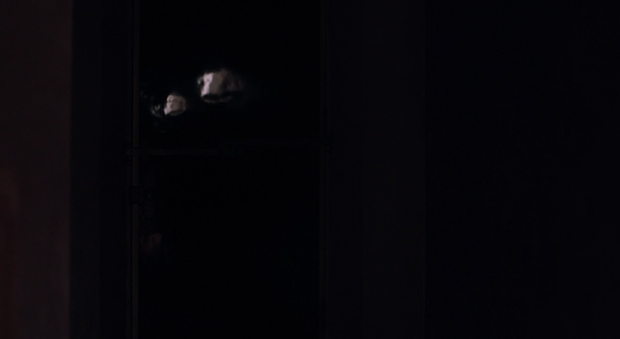
The banging door
(156) The woman in red again speaks.
AMERICAN GIRL: You'd better hurry. My mother's
coming.
The Experiment is also called Mother due this scene, individuals equating the banging with the Experiment killing Sam and Tracey. Are the two meant to equate? Let's suppose that they are. The spirit, Mike, reportedly cut off his arm as it was evil due the Fire walks With Me tattoo, but Phillip Gerard, the man he possesses, said he lost his arm in an accident and that the tattoo read MOM. Relating this story, Gerard had cried, meant to be humorous as a mother tattoo would be considered as a far cry from evil. But if the Experiment is Mother (MOM) then that's pretty wicked.
The American Girl urges Cooper to hurry as her "mother" is coming, but we have been stuck at 2:52 since about shot 118, and we will still be at 2:52 at about shot 195. Indeed, we never see Mr. C's Lincoln clock advancing beyond 2:52, we will only imagine it has happened due events that occur the last time we view the Lincoln clock. To see the clock stuck at 2:52 here is one thing, we can explain that away due the unreality of the situation, but what of Mr. C in his seemingly normal, physical world in which he is driving in his car down the highway? Shouldn't time be moving for him? For one who is standing outside his car, watching the scene, what would they see if they were experiencing time "normally" and Mr. C's car is careening down the highway while his clock is unable to move past 2:52? Do Lynch/Frost even intend for us to consider this? I am going to take it for granted we are supposed to meditate on it due the manner in which time operated when Cooper was with the blind woman, it repeatedly being nudged back, scenarios beginning several times over. Time jacking us around was the first thing encountered in this room. We had felt, when we left the red/mauve colored atmosphere, that this had been corrected, as the stuttering movements of time had stopped. Only now we find, with American Girl, that we are sitting still at 2:52 and not moving forward in time at all. Which reminds of Heisenberg, which I've discussed earlier, and the incident in the Red Room when Cooper's coffee was solid then fluid.
What if "mother", like the Kali principle, is only negative in certain aspects, while positive in others. Like life itself, conducted within time, so that we have entropy, we have decay, we have consumption of the energy of other life forms in order to simply continue existing, we have death in order for life to continue?
But that Experiment was pretty nasty.
(157-159)
Cooper begins to be pulled, head first, into the outlet. (160) The woman. (161) The door.
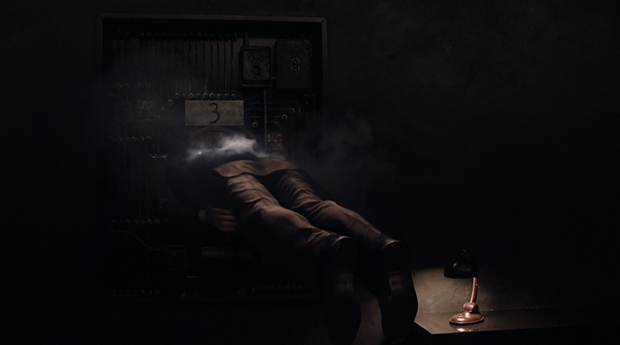
Cooper passes through the #3 outlet
(162) His body passes through but, amusingly, his shoes do not. (163) His shoes
drop off and are left in the room. (164) The woman. (165) The outlet.
(166) Cut again to Mr. C (167) as the
road before him doubles, much like the Red Room had doubled in part two. (168) Mr. C. (169) The doubled road. (170) Mr. C. (171) Green static field of the radio display then the outlet. (172) Mr. C. (173) He drives off the right of the road. (174)
He swerves left to correct. (175) Mr. C. (176) The road. (177-189) His car swerves up a right hill and crashes, flipping over.
(190) Mr. C, his window broken out. (191-194) We still hear the hum and then a scratching from the outlet, as Mr. C holds his hand up to his mouth in an attempt to keep from vomiting.
(195) We return to an earlier shot of the Lincoln's clock, still at 2:52. (196-199) Mr. C., the outlet, Mr. C., the outlet, Mr. C. (200) Out the windshield we see the curtains of the Red
Room.
Maybe the clock is now frozen at 2:52 in the Lincoln because it's been wrecked? I dunno. Did Mr. C intentionally wreck the car? I dunno. Mr. C said he had a plan for not going back into the Black Lodge. If the plan was the Experiment, was it supposed to tear him apart, but it missed him? Did the plan have multiple parts so that in case one part didn't work another part might? Was Naido and the #15 outlet also part of the plan? But she directed Cooper away from the outlet. Is the #3 outlet part of the plan? What's going on?
If this show had commercial breaks, there would be one here, and the viewer would fully expect to return and see Cooper somehow replacing Mr. C by means of that green-ringed outlet in the Lincoln.
Thus far, it's been one of a hell of a wild ride with nothing happening as we might have expected, projected, despite the fact that Lynch uses certain ideas and symbols over and over again.
COOPER IN, DOUGIE OUT
THE MISSING DRAWER / THE GREEN RING / MANUFACTURED / THE GREEN CHAIR BECOMES A BLUE VELVET CHAIR / THE MISSING FBI PIN / THE OPENING OF THE RED ROOM IN PROXIMITY OF THE SYCAMORE THOUGH NOT AT GLASTONBURY GROVE IN TWIN PEAKS / LITTLE ROCK / JADE GIVE TWO RIDES / THE SERENDIPITY OF COOPER-DOUGIE DISAPPEARING BY VIRTUE OF THE SPEED BUMP AND HIS DROPPING OF THE KEY / DRIVING IN TWO DIRECTIONS AT ONCE / INHERENT BEING AND THE HORSE IN LE SAN DES BETES, AND EYES WITHOUT A FACE
(1) Cut to a quiet street in the Rancho Rosa suburb in Las
Vegas. A billboard shows the suburb to be a place for happy caucasian
families. Not only is Rancho Rosa the Twin Peaks production company, this double R will remind those
acquainted with the series of the Mar-T Double R Diner in Twin Peaks,
owned and operated by Norma Jennings.
The viewer keeps being
assailed with the new and unexpected, and here is more of it.
The Rancho Rosa development sign, marred with stains, surrounded by tumbleweed, already looks like the broken American dream.
(2) We see then a yellow jeep and another car parked before
a house that is for sale. (3) Inside, in a bedroom, we see a nude woman
(Nafesa Williams) with a man who appears to be Cooper. She is buttoning
up his shirt. He sighs contentedly. This completely blindsides the viewer who would
have never expected to see a third Cooper. This man is heavier and the woman even pats his belly.
JADE: Dougie, what is wrong with your arm?
(4) Long shot showing the room.
DOUGIE: I don't know. I think it fell asleep. It's sort of tingly.
(5)
JADE: I'm kind of tingly, too. I'm gonna go wash up,
okay?
She takes some money from his hand, counts it, kisses him, and (6) exits to the bathroom. (7) Dougie
stands, holding his arm, (8) and we see on his left hand hand a green ring. (9) He begins to put on his jacket.
(10) His left arm useless, he has some difficulty but gets the jacket on.
Who is Dougie!? The viewers are yelling, WTF, who is Dougie, who looks like Cooper, and what is he doing wearing the green ring????
We see a dresser with one
of its drawers missing, which reminds of Josie Packard's spirit having
transferred to the wood of a dresser drawer when she died. It seems
plausible this links back to blind Naido in the mauve form of the room where
Cooper later passed through the #3 outlet.
(11) Dougie doubles over with beginning stomach distress (12) then suddenly, violently falls (13) to the
ground, ill.
The green ring is immediately recognizable to the veteran Twin Peaks
viewer, but would make no sense to the new viewer. The symbol on it is not only on the map/petrogylph that was in
the Owl Cave (see part two for more on the petroglyph) but was on a
section of the map that operated as a kind of key, so we might wonder if it operates generally as a kind of key. That was our first introduction to the green ring, by means of first seeing the symbol on it in the Owl Cave in the original Twin Peaks.
Fire Walk with Me is where we initially see the ring. In Fire Walk with
Me, Teresa Banks, the first woman murdered, was
somehow in possession of the ring, which she wore on her left hand, and
her left arm had become mysteriously numb in the days before her murder. After her death, FBI Agent Chet Desmond, at the trailer park in which she had lived, investigating her murder, found the ring on a hill of earth under a trailer said to belong to the Chalfonts. He recognized the ring due to having seen Banks wearing it in a photo. He stooped to pick up the ring, disappeared, and was never heard from again. Laura was given by the Chalfonts, a grandmother and grandson (also known as the Tremonds) a picture to put on her wall. This picture inspired a dream in which the Chalfonts directed Laura through the rooms in the picture into the Red Room. This was the dream in which in a seeming waking state she saw Annie, Cooper's future girlfriend, in her bed, who told her that she was to write in her diary that Annie had been in the lodge with them and that the good Cooper couldn't leave. During the experience Laura was given the ring, and Cooper, in the same
dream, called out to her not to take it. When she woke in the morning
she no longer had the ring. Phillip Gerard, the One-Armed Man, later
pursued Laura and her father in a camper, and tried to tell her that her
father was "the one", that he was BOB. Gerard was wearing the ring and
showed it to Laura. Then the night Laura was murdered, he appeared at
the train car where Laura and Ronette were being held, helped Ronette to
escape, and threw the green ring in the car to Laura. She picked up the ring and
put it on. The accepted idea is that BOB's intention had been to possess
Laura that night, but he was unable to do so as she was wearing the
ring. He killed her instead and her spirit entered the Red Room. In The Missing Pieces, Cooper's
lover, Annie Blackburn, was wearing the ring when she returned, with the
doppelganger, from the Red Room, but it was stolen from her by a
nurse while she was unconscious in the hospital.
In the Frost book, The Secret History of Twin
Peaks, the ring was in possession of a Nez Perce chief who carried
it but never wore it. The ring was given to Meriwether Lewis and
it disappeared with his mysterious death. Rocket man and occultist-magician,
Jack Parsons, is said to have worn the ring, given to him by Aleister
Crowley.
What the symbol on the ring means is never addressed
nor is the real power and purpose of the ring ever explained other than its seeming, in Laura's case,
to be a prophylactic against possession by the BOB entity. And yet, in
"the room above the convenience store" scene, the Man from Another Place
had mysteriously said of the ring, "with this ring, I thee wed," which
had elicited a grotesque fit of laughter between himself and BOB. Some interpret the ring as itself marrying a person's soul to BOB. And Cooper had warned Laura not to put it on.
As I've previously stated, the symbol on the green ring is
associated with fire and with Jupiter on the petroglyph, but there would
also seem an association with the green Saturn lamp in the Red Room and its green rings. This may be a reason
for the focus on the circle of green around the electrical outlet in Mr.
C's Lincoln. That the green jade ring becomes associated with the green
lamp of Saturn and its rings perhaps has to do with the Twin Peaks
mythology that when Saturn and Jupiter are aligned then the entrance to
the lodge opens, as it must have done years before when Cooper
entered it physically, not just in a vision, and which has also happened
now with Cooper's return.
Dougie wears the ring on his left ring
finger, traditionally the place for a wedding band. Supposedly the stone
is of green jade, so it is more than coincidental that he is with a
prostitute named Jade at this critical time.
How did Dougie come by the ring? But then who is this third Cooper and
how did he come to be?

The Missing Drawer
(14) Cut back to Mr. C, (15) the Red Room curtains viewed outside
the windshield, (16) he attempting to keep from vomiting.
(17) Cut back to
Dougie on the bedroom floor. (18) Jade in the shower. (19) In distress, Dougie
crawls to the bathroom, trying not to vomit until he reaches the toilet. (20-22) He
attempts to open the door but it is locked. (23) We see an electrical wall outlet. (24) Dougie crawls into the living room where the red curtains of the
Red Room appear beyond horizontal slashes of light and dark formed on the floor by the vertical blinds. (25) He vomits garmonbozia (which I will speak about in a
moment but is given as being pain and suffering as a kind of food for
The Arm). (26) There is a crash of lightning and thunder and he disappears. (27)
Jade, in the bathroom, yells out, "What the fuck was that, Dougie?!" (28) Cut to Mr. C
in his car, hand over his mouth, viewed through the red curtains of the Red Room. (29) Out the windshield he sees Dougie,
seated in the Red Room, looking back at him. (30) Mr. C. (31) The Lincoln clock. (32) The
outlet in the car. (33-44) Mr. C vomits garmonbozia and passes out, vomit and blood covering his chin. We hear a
bird in the distance.
The uninitiated viewer has no idea what it is that Mr. C. and Dougie have vomited up, that it is garmonbozia, which is caused by pain and suffering and is the food of The Arm. Even the initiated viewer might be confused as to why Mr. C does his best to keep from vomiting. I'm not confident that to the uninitiated viewer it would be clear that Dougie ends up in the Red Room because he was the one who vomited first.
(45) The curtains of the Red Room. (46) In the Red Room, Dougie looks about, bewildered, and
sees (47) Phillip Gerard. (48-50) Dougie tells
him that he feels funny and asks what is happening to him.
(51) GERARD: Someone manufactured you.
(52) DOUGIE: What?
(53-55) GERARD: For a purpose,
but, I think, now, that's been fulfilled.
(56) DOUGIE: It has?
(57) Gerard. (58) A medium long shot of Dougie showing that he, like Cooper, doesn't have on his shoes. (59-61) Medium close-up of Dougie's left hand as his arm begins to shrink. "That's weird," he says. (62) As he continues to shrink, the green ring falls to the ground. (63) With a balloon-like POP he disappears in a cloud of black smoke, (64) Gerard looking on. (65-68) A soft ringing sound as a gold ball rises from the neck of his shirt, in the black smoke. His clothes tumble down out of sight, (69) and then there hovers above the chair a black oblong shape much like a mussel shell. It becomes a seeming hollow black mass with a black hole in the front. (70) Phillip raises his arm to shield his eyes as (71) a bright light flashes--so bright that the green chair's velvet fabric briefly turns blue in the brilliance--and something begins to emerge from the hole. The gold ball again separates itself and falls to the chair as (72-76) the black mass shrinks and disappears in another flash of bright light. (77-80) All that is left is the small orb of gold on the cushion of the chair. Gerard seems to observe it with some curiosity or amazement.
(81-83) Gerard picks up the green ring and the gold ball. (84) A sound of wind as the camera pans over the zigzag floor to a black marble table-top that rests on a gold
shell base. The shell fits with the Venus statues in The Red Room, as it is a symbol for Venus-Aphrodite. Gerard places the ring on the table (85) and walks away. The folds of the red curtains crossfade into the vertical streaks of shadow and light of the blinds back at the house in Rancho Rosa, as they fall over the electric wall outlets.
As for Dougie and the ring, it seems all that the ring did for him was serve as a portal-transport to the Red Room. After vomiting up the garmonbozia, where would he have gone if he hadn't been wearing the green ring? What would have happened to him? How long was he in possession of the ring in preparation for this event?
(86) We see Dougie's vomit on the floor. (87) Two prong holes of the
outlet flash white as black smoke pours from them. That white flash may remind of the light through the two holes in the banging "door" and the approach of mother. (88) Now from across the room, we watch as in the black smoke a small gold ball briefly appears then is gone. . (89-91) Cooper forms out of
the black smoke, a hole observed in the right big toe of his sock.
We will also
notice that Cooper's FBI pin is no longer on his jacket, though it was there when
he began to be pulled through the electrical socket. He left behind more
than his shoes, but the FBI pin didn't drop to the floor along with his
shoes in the world on the other side of the socket. What happened to it?
So Cooper has returned, but Mr. C didn't go back in. Instead a "manufactured" man, named Dougie, took Mr. C's place by being transported to the lodge. Dougie taking Mr. C's place in this way, Cooper was also enabled to return even though Mr. C had not gone back in. Dougie was made, it seems, for this purpose. And he certainly didn't have a clue. He seemed like a kind of pleasant guy with Jade. Suddenly he gets sick and finds himself in the Red Room and he has no idea what's going on.
(92) Jade enters, fully dressed and ready to leave. Her name
is as the stone of the ring, but it's fairly obvious to the viewer that
she is an innocent bystander who has no clue what is going on.
(93-101) Back and forth shots of Jade and Jade looking at Cooper-Dougie lying on the floor JADE: What was that noise, Dougie? Where are you?
Dougie! Oh, my god, Dougie, what the hell? Where'd you get that suit,
and haircut? Have you been wearing a rug all this time, Dougie? (She
notices the vomit on the floor.) Oh, my god, are you sick, Dougie? Come
on, we got to get out of this house. Come on, Dougie!
(102)
Cut to the house's exterior, she leading Dougie out the front door. She
locks up. Cooper-Dougie is entirely unresponsive, simply mimicking some
of her actions. The house is one for sale and is apparently being
illicitly used for prostitution trade while it is empty.
(103-106) JADE: Dougie, Dougie, did you forget something? Your
shoes? I'll get them. (107) She goes inside. Cooper follows her but she
doesn't notice. When she comes back out she glances around for him and
he follows her back out. JADE: Dougie? Could you quit fucking around? (108-117) JADE: Put on your
shoes. Here. Put on your damn shoes! Come on, let's go. All right. You
do have your keys, right? (118) She checks his pockets (119) and finds a key (120-121) to
Room 315 at The Great Northern Hotel in Twin Peaks, WA.
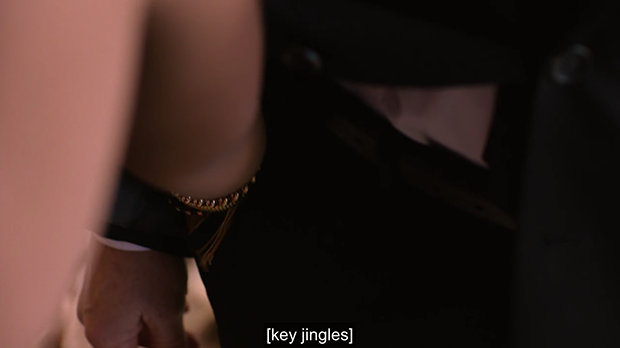
(122) She puts the key
back in his pocket. She finds no other keys. (123) JADE: You mean Jade has to give you two
rides?
Cooper literally steps into Dougie's shoes, his own left behind.
The shape of the green Great Northern Hotel key ring bears a similarity to the quadrangle
symbol on the green ring that Dougie was wearing, though it is not
exact. The reason I provided an image of Jade's bracelet is because it is made up of gold beads, so we have Jade wearing a gold bead bracelet and pulling out of Dougie's pocket the green key ring. This all parallels Doug in The Red Room wearing the green ring, that falls off his hand, and all that remains of him after he goes poof is a little gold ball on a blue chair.
Stepping back to the absence of the FBI pin. Cooper has retained the #315 key that was in his jacket pocket, but he's lost the FBI pin?
(124) Cut to the pair in Jade's yellow jeep. (125) They pull out of the drive and we
see the Nevada license plate of Dougie's car reads DUGE LUV. (126) As they go
down the street they pass a burgundy red car (1971 Chevrolet Chevelle) with two stripes down the
hood. The driver is Gene (Greg Vrotsos).
Some will wonder if
DUGE LUV might signify that Dougie has an association with lore of black
magicians called dugpas. Windom Earle had been interested in such and
had spoken of them as evil sorcerers who cultivated evil for the sake of
evil. However, Dougie, in the Red Room, seemed to not know where he was,
and he had no idea of what was happening to him.
(127-129) GENE (on walkie-talkie): She just drove by in a
Wrangler. Looked like maybe two people, but his car's still here.
(130-132) BEARDED MAN IN BLACK CAR: I'm all set near the entrance. If he's in the
car, I'll get him here.
(133) Cut to Jade and Cooper-Dougie.
JADE: Once you
find your wallet or your cell phone, a pay phone or some money, you can
call Triple AAA, Dougie. They will help you.
We note behind them a cul-de-sac with a car with a blue cover.
(134) Cooper-Dougie notices the street signs, (135) the street they are traveling on
named "Little Rock" and the cross street named "Sycamore".
As I had gone into in Part Two, Glastonbury Grove, the entrance to The Red Room /
Black Lodge near Twin Peaks, had a small pool or well filled with a black substance
like oil and was surrounded by Sycamore trees. Dougie was at the Las
Vegas equivalent of this as shown by the Sycamore street sign. Mr. C was
somehow at the Black Hills equivalent of this, but the primary anchors
we are given for him are the electrical outlet circled with green and
the Lincoln clock, Lincoln Street in Blue Velvet having been
the place where Jeffrey entered, for him, the alternate universe of Dorothy.
(136) COOPER-DOUGIE: Jade give two
rides.
JADE: Oh, my god.
This is curious that Cooper-Dougie says this instead of repeating what
Jade has just said, which is what he will often do from here on out, repeat back the last thing that is said to him. "Jade give two rides" is also the first thing he has managed to
say, and he only does so after seeing the Sycamore and Little Rock street signs.
(137-138) Cut to the black car. In a long shot we see a cerulean blue object, like a child's pedal-car, abandoned at the end of the street to screen center.
(139) Then back to Cooper-Dougie and Jade. (140) We are shown a foreclosure sign handled by a Peter Glavich, and a "Speed Bump Ahead" street sign (141-142) as Cooper-Dougie reaches in his pocket to look at the key.
(143) Jade hits the speed bump, Cooper-Dougie drops the key and bends over to look for it. (144) Shot of the jeep from behind and in the distance a car in a driveway covered with a cerulean blue cover.
(145) Cooper-Dougie still bent over and out of sight. (146) A long shot of the yellow jeep.
(147) The man in the black car cocks a rifle and points it at the Jeep as it passes, (148-150) but he only sees Jade in it. (151) After they have passed, Cooper-Dougie sits back up.
We are given to understand that
Cooper-Dougie's having just escaped being shot and killed may not be a
simple happy accident but a synchronicity packed with intention.
2:52 and Cooper's experience in the purple universe led to a consideration of time and relativity. For instance, Mr. C's car moved at a seemingly normal rate of speed but the clock was stopped at 2:52, so did that actually mean he was moving so quickly he wouldn't be seen by the normal observer? We don't know. But Lynch/Frost do use the speed bump here to facilitate Cooper-Dougie's seeming to disappear from the car, though he has only bent down to pick up the key that he dropped.
If I have paid special attention to the cerulean objects it is because they are center stage, both are related to vehicles, and occur in close proximity to Cooper-Dougie's seeming to disappear in the car, the hitman unable to see him with Jade. I had already made a comparison between the green key ring and Jade's gold bracelet and the green jade ring on Dougie's hand and how after he goes poof there is only the gold bead remaining on the blue chair. You will notice that Jade is driving away from the cul-de-sac with the blue-covered car before we see the Sycamore sign and Dougie takes out the key ring and drops it, then she is driving toward the same cul-de-sac with the blue-covered vehicle when Dougie is stooped down and avoids being shot because he's not seen. I don't think this is accidental, just as I don't think other reversals are accidental.
(152-154) BEARDED MAN IN BLACK CAR: Gene, he's not in the
car.
GENE: Yeah, he must still be inside. I'll load up his car.
BEARDED MAN IN BLACK CAR: All right. I'll see you at
Mikey's.
(155-156) As Jade's jeep passes the Rancho Rosa sign, we see a homeless figure in
black pushing a cart down the street.
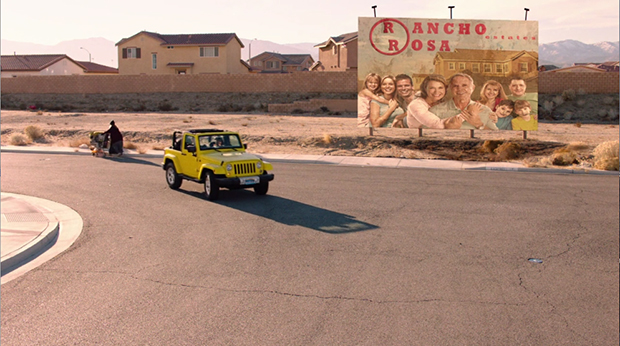
Homeless person enters as they exit
Associations have been given in this section between this area in Las
Vegas and Twin Peaks. There was the Double R Diner (RR in this case
refers to the railroad) linkage with the double R of Rancho Rosa. There
was Sycamore as a cross street. Dougie was in possession of the
mysterious green ring and was with a woman named Jade. In Lynch/Frost
universe, enough correspondances were fulfilled that Cooper was able to
be transported in and take Dougie's place, filling his shoes. Not to
mention that Dougie, it seems, may have been manufactured for just this
purpose, but we don't know by whom. Dougie doesn't appear to know
anything about this. Even Gerard appears baffled when he says that "someone" manufactured Dougie and appears to have served his purpose, or it may be that Gerard knows what is going on and his use of "someone" is a simple relaying of information rather than his making a conjecture.
We've had several
instances where Josie Packard may have been referred to, and she may or
may not be referred to again with Cooper-Dougie's not insignificant loss
of weight. When Josie died, though she appeared to be a healthy young
woman to the viewer, a mention was made that she only weighed sixty-five
pounds. The viewer was forced to wonder where that weight went. Did this
lightening signify the absence of her "spirit" that was observed entering the wood of
the lodge? Cooper-Dougie has lost a significant amount of weight, but
this ultimately may be only to differentiate, for the viewer, Dougie
from Cooper, and to keep the viewer aware that Cooper's body has
replaced that of Dougie's, that it was not a matter of the spirit of Cooper taking over Dougie's body.
We do know that someone wants Dougie dead. But who? With what was Dougie
involved that someone wanted him dead? It seems too odd that at this
critical junction, when Cooper ends up taking Dougie's place, rather
than the doppelganger's, that a hit has been arranged on Dougie. If Dougie
hadn't "been", then would Cooper have taken the doppelganger's place as
was supposed to happen? Did Mr. C create Dougie, somehow, so that Dougie would be the one pulled into the lodge? If this is the case, Dougie's existence works to benefit both Cooper and Mr. C in buying them some time, it seems. Mr. C didn't return to the lodge because he was able to keep from vomiting, so Dougie's presence benefited him. And since Mr. C didn't vomit, Dougie's existence benefited Cooper as he was able to take his place. Previous to this the only other Las Vegas connection we have is Duncan,
who seems likely to have arranged a hit. Was it this hit? But it was a job given to a woman. Duncan was terrified of the individual for whom he was working, so it was pretty obviously Mr. C. it may be that the doppelganger was
counting on Cooper replacing Dougie and that the hit then was actually
intended to be for Cooper-Dougie after the transfer had taken place.
Cooper, in taking Dougie's place, becoming Cooper-Dougie, is certainly
not Dougie, not shown as inheriting his memories or personality, but is
also no longer the Cooper we have known. Which doesn't mean he's no
longer Cooper. He's physically been transmitted but his memory and
personality have been dampened in the extreme, to the extent of seeming
to have been nearly lost. He is as a child. He can only relate through simple mimicry, repeating
the words and actions of others, occasionally showing an affinity for
symbols and things that resonate. He is not a child, however, as he doesn't make the demands that a child would make. He is instead the prototypical fool on the
fool-hero's journey who finds himself in a strange land and can only relate by reflection, by mimicry.
If we take a look back at what I wrote at the
end of part two, on Buddhism and the emptiness of inherent being, then
Cooper-Dougie now exemplifies this. The viewer has been expecting the
return of Cooper. As far as they are concerned, with the return of
Cooper's physical body to this realm, this is Cooper. But Cooper is
dramatically not what they expected him to be. He is nothing of what
they "inherently" expected to be Cooper. Is the essence of the bicycle
its seat its metal? Cooper is here, by all appearances, but where is
what the viewer expects of Cooper? It's a jolt that what they expect
hasn't returned with the body, or appears not to have. What is there
instead is a being who responds mostly in the moment, memories muted,
hapless to do anything but take cues from the environment, which may be
what Lynch/Frost might conceive of as a purest way of existing.
In connection with the emptiness of inherent being, I am reminded of
Lynch's relation of a film he saw of the destruction of a white horse.
Others have written that this white horse may be associated with Sarah
Palmer's visions of a white horse and that Lynch was horrified by the
horse's slaughter. I took something a little different from Lynch's
tale of the slaughter of the white horse in Georges Franju's Le San
Des Betes. If I remember correctly, the manner in which Lynch
described it, at least in the interview segment I saw, was not so much
his horror of the slaughter but how he was struck that there was this
white horse and that within a matter of minutes of swift and efficient
deconstruction there was nothing left of what had been at first the
white horse. My take on this is that the horse is much like the bicycle
example for the emptiness of inherent being. Where is the essence of the
horse once it has been deconstructed?
Lynch is not so horrified by "corruption" of physicality when he has, throughout his life, made a practice of examining decay of living creatures and incorporating them into his work.
Frankju was the director of the 1960 horror film Eyes Without a
Face which concerned identity. Just as Twin Peaks, the
series, opened with the body of Laura being found in the river, Eyes
Without a Face opens with a young woman's body being disposed of in
a river, and a doctor later identifying the remains as being that of his
daughter. However, the body was not that of his daughter. His daughter's
face was disfigured in an accident and he has kept her in hiding. The
doctor tries to give his daughter a face that has belonged to
another. The woman who was put in the river was the first victim of such
a grafting that had failed. Another woman's face is acquired, but that
grafting also becomes a grotesque failure. The doctor's
daughter loses her sanity due all this. The question raised,
of course, is that of identity. What is it? Is it the matter of a physical face?
What does that face mean to us spiritually, personally, and as a matter of
community? Kobo Abe raised the same question in his 1964 book, The
Face of Another, and then in the film adaptation of it in 1966 by
Hrioshi Teshigahara.
Naido, perhaps the Non-existent Path, rather than being "eyes without a face", is a a face without eyes.
THE BLUE PILL
REVERSAL OF 911 FOR 119 / SALTY, CRUNCHY / BLACK LABEL / THE DESPAIR BEHIND THE SMILING BILLBOARD FACES OF RANCHO ROSA/ SALT AND ALCHEMY AND ITS RELATIONSHIP TO DOUGIE'S COMBUSTION
(1) Continuing, we view through a window as Gene gets out of
the red muscle car. (2) Cut to a boy (Sawyer Shipman) (3) watching him through
this window. (4) The boy's mother (Hailey Gates) calls out...
DRUGGED-OUT MOTHER: One-one-nine! One-one-nine!
One-one-nine!
The viewer connects the mother calling out this
one-one-nine as the same kind of reversal that might happen in
connection with the Red Room. She has somehow plugged into it and is
serving as a medium for it. She is also proclaiming an emergency.
(5) Gene approaches the car and (6) in a close-up shot plants a bomb with a red blinking light under it (7) then returns to his own, (8) the boy
watching through the window blinds. (9) Gene drives off. (10) Cut to the interior again of this house across from the one
where Dougie had his liaison with Jade.
DRUGGED-OUT MOTHER: One-one-nine!
The boy, seated on a couch, turns and faces his mother.
The white vertical blinds in the house where Jade and Cooper-Dougie had been are exchanged here for black horizontal blinds. I only note this because they are black, otherwise I wouldn't think anything of them.
(11) The mother is at a card
table. Against the wall behind her is a red balloon. On the card table
is an empty glass, a pack of cigarettes, a Poker card box and a deck of
cards, a pile of dust, an open safety pin, a bottle of black label Evan Williams manufactured by Heaven Hill, a
lighter, an ashtray, two empty pill bottles. She opens a third pill bottle
and takes out a blue pill and sets it on the table before her. She pours
herself a drink. She stares at the pill then takes it.
I did not make the connection myself, but saw another wonder if the open safety pin near the poker cards on this table had anything to do with the scratch marks on the poker card Mr. C had that showed what he wanted.
(12) The boy picks up a box of Saltines and eats a cracker. (13) His mother lights a cigarette and sits back.
The busted white lamp may remind us of the black mass with the hole in it into which Dougie had resolved, out of which dropped a gold bead and then the mass had disappeared. It might remind of the Experiment's face and its ravaging hole of a mouth.
This is a nightmare version of the American Dream. It doesn't look like Heaven. All the homes are being foreclosed on. The subdivision is going to ruin. People's lives are broken.
The boy functions as a witness to the bomb being placed
under Dougie's car--but for what reason? His mother seems to be in a Red
Room space in her mind, calling out 911, meaning an emergency, though
backwards. One may not only associate this emergency with the bomb that
has just been planted, but with the following scene, in which Mr. C is
found by the State Patrol. One may also return to the police cars of Buckhorn, responding to the murder of Ruth Davenport, and perhaps in particular the car that had 116 rather than 119 with a reversed 9. The mother will take a blue pill and we've seen in the previous scene how Jade ends up driving in two directions at once, as highlighted by a blue-covered car.
Emotionally we may not be able to connect much with
either Dougie or Cooper as their situations are too abstract at the moment. But we
have sympathy for the boy who is experiencing the damage
of living with a mother who is out-of-control and non-present.
Thus far, there has only been one other reference to drugs, and it was
with Jerry eating banana bread into which he'd baked some mj, he fairly
gloating as he entered Ben's office, "Salty, crunchy." So there may be
some association between these scenes, the boy sitting back with his Saltine crackers while his mother takes her blue pill. At the end of the Ben and Jerry
scene, Ben had abruptly asked Jerry if he was wearing "mother's hat",
and here we also have a woman whom we are supposed to strongly register
as a mother.
According to Paracelsus, salt was the essential that remained of the physical body after its combustion. It is the corporeal substance that survives death to inaugurate new life. It is the "fulcrum of death and revivification". This interpretation of the salt seems appropriate in proximity to Dougie's demise, in a puff of black smoke, and Cooper taking his place.
Fine and good, but there is a very real horror story here that is not to be intellectualized out of existence. The suburbs, presented in the advertising on the Rancho Rosa billboard,
are a place of happy (white) lives, happy (white) families, but the
first family shown living in the suburb presents an environment of
despair. There is no happy future imagined for this mother and son.
Sooner than later, the boy will likely be found wandering the street,
looking for food, for help.
Following Cooper's harrowing journeys through the glass box, his fall
through the seeming starry universe (or the one that expresses the same
particulates of Henry's brain erasure in Eraserhead), his replacement of Dougie provides a fair amount of comedy. That
stress-relieving comedy is countered by the sad story of the boy in the opposite house,
his vulnerability, his solitude in the company of his mother who is
being apparently destroyed by drugs, and perhaps more specifically by this
mysterious blue drug. What it gives her in exchange for this destruction we don't know, but it has removed her from her child.
Is the fact this is a blue pill (however light blue) intended to
connect the viewer to the film, The
Matrix, its famed blue pill being the choice for "falsehood, security, and
the blissful ignorance of illusion" (Wikipedia), whereas a red pill
would be a choice for "knowledge, freedom, and the (sometimes painful)
truth of reality" (Wikipedia). The blue pill is for individuals who would remain unaware of the matrix, for whom "the story" ends when they wake up in their comfy beds, the memory of an alternative reality forgotten, and continue to believe what they want, while the red pill keeps one in the environment where truth is pursued.
Would Lynch make such an association or is it going to have his own highly personalized interpretation? Right now I would think that most likely the blue pill is intended to remind of the blue rose.
Remember, Jacoby's glasses have the red lens over the right eye, working to suppress the logical side, while the blue on the left eye suppresses the intuitive side, the combined purple resulting in better balance.
Thus far, in Twin Peaks, all that we know about the blue rose is its association with paranormal cases and that we observed it in the room with the #3 outlet after the switch on the generator had been thrown, the mauve/red light rescinded, and the head of Major Briggs had passed by in the firmament announcing, "Blue rose."
C TAKEN INTO CUSTODY
(1) A medium close-up of C's wrecked Lincoln, the driver's window busted out. Sirens. (2) A Highway Patrol car, its red and blue lights flashing, drives down the highway to Mr.
C's automobile (South Dakota license plate TJF 397) and parks behind it. Two officers
get out of the patrol car and approach the automobile . The
officer who first approaches the car, checking Mr. C, begins to gag and
falls to the ground.
SECOND TROOPER (Stephen Heath): What the hell, Billy?
FIRST TROOPER
(Traves Hammer): Oh, God. Something awful's in there.
SECOND
TROOPER: Dispatch? We need an ambulance. And tell them to bring gas
masks. There is something bad in this vehicle. (Helping Billy up and
away.) Come here. You'll be all right.
Are you surprised C would still be passed out? I am. I had this idea C was nearly invincible. Losing all that garmonbozia must have sucked his battery charge down to nothing.
With Mr. C unexpectedly taken into custody by the police, we expect things to move along in pushing forward the story of Cooper and the doppel as we believe that the doppel will soon, by his prints, be identified as Dale Cooper. That means an appearance by the FBI will likely soon follow.
IT'S NOT ABOUT THE BUNNIES
THE PROBLEM OF KNOWING WHAT IS MISSING
(1) Rays of sun shine above pine trees and birds chirp. Pan down to show the Sheriff's Department sign.
(2) Interior shot of Hawk opening a door and hanging a Do
Not Disturb sign on its exterior. The sign is a picture of a doughnut
with DISTURB beneath. He closes the door. (3) Inside the conference room we
see Andy and Lucy seated at the long table, documents spread over it and
several boxes at the far end, two with red X's. There are other archival boxes as well that don't have the red X's. Hawk places a white box
and a pink box on the table. The white box has a slanted top and at the
bottom reads RR 2g0! We will see that the pink box also reads RR 2g0! (4) Hawk takes a seat in front of the pink box. (20) HAWK: What is it?
This scene, by virtue of the RR on a to-go box from Norma's diner, connects with the previous scenes that occur at
RR, Rancho Rosa.
ANDY: We laid everything out, Hawk, and we can't find
anything that's missing.
HAWK: If it's not here then how do you know
it's missing.
LUCY: But if it is here then it isn't missing?
ANDY (gesturing at the documents): This...is here.
HAWK: Let's sit
down. (He realizes he's the only one standing.) Let...let me sit down.
HAWK: Let's start from the beginning. (5) Andy
reaches for a baggie and begins to interrupt. HAWK: And don't say a thing! (6) HAWK: I
need to think out loud. (7) Andy listening. (8) HAWK: Something is missing and I need to find it. And
the way I'm gonna find it has something to do with my heritage.
(9) LUCY: You are an Indian. (10) Hawk looks at Lucy like he can't believe she would ask/say this after this many years. (11) Lucy. (12) HAWK: Yes, Lucy. (13) Lucy. (14) HAWK: And, apparently, that's
the way I'm going to find what's missing.
(15) Andy. (16) Lucy's eyes scan the table. (17) Lucy looks at
a pink box of chocolate bunnies that reads "Ears in the Making". It's beside a file with the date 2/24/89, the day Cooper arrived in town, and below a diary of Laura's. (18) She
gasps. (19) Andy looks at her.
(21) LUCY: Ah!
Ah!
(22) ANDY: Are you okay, Pooky?
(23) LUCY: I know what's missing!
HAWK: What's missing?
LUCY: The bunny! The bunny. I ate that bunny!
(26) ANDY: That's missing. That's missing. (27) Hawk. (28) ANDY: Do chocolate bunnies have
anything to do with your heritage?
(29) HAWK: No. It's not about the
bunny. (30) Andy. (31) HAWK: You ate the evidence, Lucy?
(32) LUCY: I know. And I never did it
again. And I only ate one. And I never did it again. (33) Hawk. (34) LUCY: But I had a problem
at that time with--and I don't like to say this in front of Andy... (35) Andy. (36) LUCY: ...but I
had a bubble of gas.
(37) Andy. (38) LUCY: And I had read that sometimes chocolate, which I
love, can be used as a remedy. Maybe by indigenous people? Is that true,
Hawk? (39) Hawk. (40) LUCY: Do you use chocolate as a remedy for gas?
(41) Hawk.
(42) ANDY: Do you want
another bunny, Punky? (43) Lucy. (44) ANDY: I can get you more bunnies.
(45) HAWK (emphatic): It's not
about the bunny! (46) Andy. (47) Hawk. (48) Lucy. (49) Hawk. (50) The bunny box. (51) Is it about the bunny? (52) Andy. (53) Lucy. (54) HAWK: No. (55) Andy. (56) Lucy. (57) HAWK: It's not about the
bunny.
(58) Lucy sighs in relief.
Oh, so Lucy and Andy are one of *those* couples, though, to Lucy's confession of having ever experienced a gas bubble, Andy valiantly responds with acceptance of the revelation and offers to get her more bunnies.
The officers, made ill by the garmonbozia in the previous scene, had called for gas masks. Now Lucy has a tale of a gas bubble which caused her to eat a chocolate bunny that was part of the evidence in the Laura Palmer case.
It would seem that Lucy would have eaten the chocolate bunny when she
was pregnant with Wally, before Cooper's disappearance, when the Laura
Palmer case was still active.
As an aside, the candy box reminds me of
Cadbury chocolates and the popularity of Cadbury eggs and bunnies at
Easter, a time of resurrection, and Cooper has in effect just been
reborn. Cadbury Castle is located in Somerset, as is Glastonbury, which
is twelve miles away. It also also comes with its own Arthurian
legends, the hillforte having been said to be King Arthur's
"Camallatte." Legend also had it that King Arthur slept in a cave beneath
either Cadbury or Glastonbury, and would one day return when most
needed. A causeway that is known as King Arthur's Hunting Track
connects Cadbury to Glastonbury Tor.
It's to be noticed that the bunny box has on it the graphic of an egg decorated with a zigzag design though in different colors from the Red Room floor. Another egg has a straight line design and we had observed vertical lines of shadow and light overlaying the electrical outlet as the folds of the Red Room drapes faded away at the house in Rancho Rosa.
The only other bunnies I can think of right now are two porcelain bunnies observed in the Palmer household, in part one, while Sarah was watching the footage of the lions attacking and devouring the buffalo. The bunnies were situated directly in front of the television on the table holding it.
There could possibly be information to be gleaned from watching Lynch's Rabbits.
Hawk's uncertainty reflects
the uncertainty of the viewers. No, it is not about Lucy's bunny. Or
might it turn out to be about Lucy's bunny after all. One never knows.
It may occur to us that in the previous part we had seen Hawk at the Sycamore circle in Glastonbury Grove, yet there is no clue given here that journey never took place.
JACOBY'S SHOVELS
FROM CALLING FOR GAS MASKS IN SOUTH DAKOTA, TO LUCY DEALING WITH A GAS BUBBLE TWENTY-FIVE YEARS AGO, TO JACOBY WEARING A PROTECTIVE MASK WHILE PAINTING HIS SHOVELS, AND THE RELATION TO COOPER'S AND ALBERT'S DISCUSSION ON SKRYING THE ASSOCIATIVE
Cut to Dr. Jacoby (1) stepping on a foot pedal, (2) that slides his shovels, that hang on a rack. (3) In a long shot we see he wears a protective mask as he begins spraypainting his shovels gold. These had been delivered at the beginning of part one. (4) A shot of Jacoby from the front. (5) A shot from the rear, as he presses a pedal that moves the shovels to the left so he can begin on the next one. (6) From the front. (7) From the rear as he paints a 3rd shovel. (8) From the front. (9) A shot of the right wheel of his rack from which the shovels hang. Pan down to Jacoby spraying a 4th shovel. We hear only a slight breeze. (10) His foot taps a pedal. (11) He sprays the fifth shovel. (12) Jacoby from the front. (13) He taps the right pedal twice. (14) The shovels turn around so that he may spray them from the rear. (15) From the rear, Jacoby spraying the next to last shovel. (16) A long shot of Jacoby hanging the shovels on a drying rack. (17) Jacoby hanging his shovels, no longer in his mask, wearing his red and blue glasses.
Watching Jacoby paint his shovels one by one slows the viewer down again to a meditative pace.
Jade had not seemed to be made physically ill with Dougie's vomit, but with the discovery of Mr. C and his toxic vomit, the
trooper had called for gas masks. Lucy said she had a bubble of gas
which is why she ate the bunny. Now Jacoby uses a protective mask,
spraying his shovels gold. Gas/toxic fumes connect these several scenes.
The viewer can learn a little about associative elements through a conversation once had between Albert and Cooper.
ALBERT: Cooper, the ooze of mumbo jumbo is rising up above our heads. Do you honestly think Cole's practice of word association works?
COOPER: The very fact that we are talking about word association means we are in a space that was opened up by our practice of word association. The world is a hologram, Albert.
ALBERT: Yes, it's a great big psychedelic circus ride, isn't it, Cooper?
COOPER: Albert.
ALBERT: You said, "Teresa Banks", so you think something is going on somewhere in the world right now that is connected with her murder?
COOPER: Yes. Either right now or right when I thought of it.
In other words, it's about the bunnies and a host of other things as well.
CALL FOR HELP
YOU CAN GO OUT NOW / LINCOLN AND THE FIVE DOLLARS AND THE LINCOLN'S CLOCK AND LINCOLN STREET / THE SILVER MUSTANG AND THE PALE HORSE / MEG FOSTER AND THEY LIVE / THE STARRY RUG / DOUGIE-COOPER AS THE INNOCENT FOOL
(1) The Silver Mustang Casino. Two pigeons fly down before it which will remind us of ??????? telling Cooper to remember "two birds with one stone". There is no stone. (2) Cut to Jade pulling up before the door and stopping. Perhaps we are intended to connect the Silver Mustang Casino back to the white horse that Cooper saw in Part Two after his talk with Laura.
JADE: All right. Go inside, Dougie.
Someone will help you in there.
COOPER-DOUGIE: In there.
(3) From Dougie's right. JADE:
Right. And I think you should try to forget you ever met me. Shouldn't
be too hard for you. Now here's five dollars. Call for help.
(4) From Jade's left. COOPER-DOUGIE: Call for help.
(5) From Dougie's right. JADE: Right. And I think you should
maybe call a doctor or something because I think you might've had a
little stroke or something.
(6) From Jade's left. COOPER-DOUGIE: Something.
(7) From Cooper's right. JADE: Yes.
You can go out now.
(8) Cooper-Dougie flashes back to Laura telling him, "You
can go out now." As I had said earlier, the Silver Mustang Casino may
have intended to remind us of the white horse Cooper had seen after his
talk with Laura in which she told him, "You can go out now." She had
then revealed that she is dead but still lives, unmasking herself and
showing a bright light within. It is unknown if Jade's saying "You can
go out now" is a simple associative coincidence or if we should look upon Jade as
representing that Laura "lives" on less as a personality than as part of
an interconnective principle of life spirit dwelling in all
things.
Jade has given Cooper-Dougie a five dollar bill. What we
don't see is that the five dollar bill has the head of Lincoln on the
front. This connects back to Mr. C in his Lincoln car and our being
shown 2:52 on the "Lincoln" clock, 2:53 being the time of transference, when Cooper could go out, only he has
landed in Dougie's life rather than trading places with Mr. C.
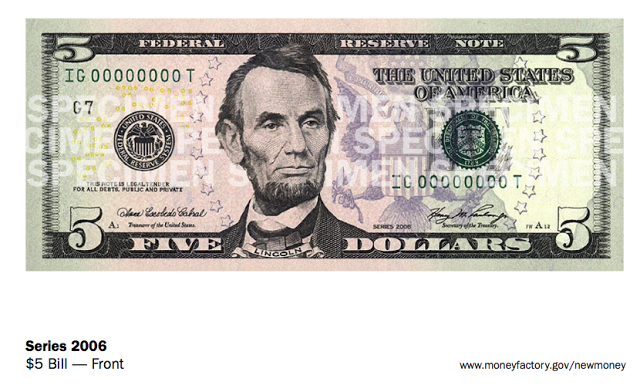
Lincoln
Lynch refers over and over to Lincoln. Lincoln Street was the border to the underworld in Blue Velvet, Dorothy's apartment building being there. The borderline of 2:52 and 2:53, of "You can go out now", is represented on the Lincoln clock. Jade gives Cooper-Dougie a five dollar bill and tells him to call for help and that he "can go out now".
(9) JADE: Dougie, go. She undoes his
seat belt. JADE: Come on, let's get you out of here. Come on, let's go,
Dougie. (10) Dougie from Jade's left. JADE: (Pushing him out of the SAHARA seat.) Right, right.
Cooper-Dougie wanders toward the casino's door. (11) Jade closes the car
door, which he'd left open, (12) and rides off, Cooper-Dougie standing, bewildered, before the revolving door.
The casino security
guard turns and looks at Dougie standing before the door. Cooper-Dougie
watches it, wanders into it, and eventually makes his way through. (13) He
crosses the Silver Mustang Casino logo on the floor (two dice enclosed in a horseshoe and surmounted by the letter M) and approaches
another security guard. He holds up the five dollar bill and says, "Call
for help." The guard points to the rear, telling him, "In the back,
Jack." As Dougie wanders away, the guard yells, "Hey! You're gonna need
some change!" He points him to the cashier's box.
Dougie says,
"Some change", and wanders over to the cashier's box which has bars
across the front.
(14) COOPER-DOUGIE: Some change.
(15) CASHIER (Meg Foster):
Well, how do you want it? (Gently.) You gonna play a game?
COOPER-DOUGIE: Game.
(16) The cashier from his right, she having taken his bill. CASHIER: What game are you gonna play?
(17) From her left. COOPER-DOUGIE: Call for help.
(18) The cashier, concerned,
(18) hands him the cup, clasps his hands around it, (19) and points to the rear. (20) View from her left as she guides him to screen right. (21) Medium shot of her as she looks after him, worried.
We've had ample time, with her clasping his hands to the cup, to see she wears a green ring that is similar to the owl cave symbol ring but is not that ring.
The cashier is played
by Meg Foster who was in the cult classic They Live,
directed by John Carpenter. In that film, John Nada (Roddy Piper) finds
a pair of sunglasses and putting them on he learns that he is able to
see aliens who appear to be human, the sunglasses stripping away their human
camouflage, and is also able to see that advertising is all subliminal
commands to humans urging conformity and consumption. Meg Foster
played Holly, who John Nada believed was an ally in the battle against the
aliens, but turned out to be a human in their employ.

Cooper-Dougie exchanges his 5 for
coins
(22) Cooper-Dougie wanders over to the slot machines. (23) He
watches one man play Tropical Treasure. (24) Cooper-Dougie. (25) Getting 3 7's, the man (John
Ennis) calls out "Hello!" as coins pour forth. (26) Cooper-Dougie. (27) The man gathers his coins. (28) Cooper-Dougie looks
around (29) and sees the Red Room within a flame hovering over a FIVES & SPARKLERS machine. (30) He
approaches the Fives & Sparkler's machine. (31) The Red Room flame above it
looks somewhat like a red flashlight pointing down to the machine, a
light beam emitted that has in it red zigzags. (32) Uncertain, he sits before it. (33) He rubs a coin as he had seen the man do. (34) Cooper-Dougie puts a coin
in and pulls the lever. (35) He yells out hello even before he hits the jackpot and
money pours out and sirens blare. A man comes up (Josh McDermitt) and
tells him, "You broke that one. You broke it real good." Cooper-Dougie
repeats, "Broke it". The man replies, "Sure did, pal."
(36) Cooper
sees another Red Room flare above the Martini Madness machine.
(37) He sits down at the machine, (38) rubs the coin, (39) plays. (40) He yells, "Hello!" (41) Another jackpot and sirens. (42) He sees the light above the machine now disappears.
(43) COMPUTERIZED VOICE: Mega-mega
jackpot.
FLOOR ATTENDANT JACKIE (Sabrina S. Sutherland):
Congratulations, sir. You are a mega winner. You've just won two mega
jackpots for a total of $28,400. It's much more than these
quarters.
COOPER-DOUGIE: Call for help.
JACKIE: Oh, well, that's
what I'm here for. Let me get you a bigger bucket.
(44) Cooper-Dougie looks over (45) and sees another flare over a machine beside an unkempt older
woman, Lady Slot-Addict (Linda Porter). He points to it. She looks up
and says nothing. Refusing to change machines, she shoots him a bird and defiantly says, "No!"
Cooper-Dougie wanders away leaving his coins. The woman looks at them,
looks up at (46) the eye of a security camera in the ceiling, (47) shoots a bird
at it and returns to her game. We might remember "two birds with one
stone", but there is no stone. This seems just a humorous nod to the
"two birds".
(48) Cooper-Dougie continues his wandering. (49) Hearing guitar strums (guitar
strums have accompanied these apparitions) he turns and sees two more
flares, then three. (50) He heads in their direction. (51) Cut back to Jackie and a security guard looking for him. The
Lady Slot-Addict says, "The nutcake left." Jackie tells the security
guard (Bill Tangradi as Jake) to watch the Martini machine.
(52) Cut
to Cooper-Dougie holding up another coin and rubbing it. (53) An overhead shot of him before the Big PayDay machine. We see, with this
overhead shot, that the carpet is blue with gold stars with red centers,
reminding of his falling through starry space. (54) He drops in the coin. (55) He pulls the lever, (56) calls
out, "Hello!" (57) 3 7's. (58) Another jackpot! More sirens. (59) The old woman hears. (60) Overhead shot of Cooper-Dougie. (61) She rushes
over to see. (62) Overhead shot of Cooper-Dougie. (63) She then goes and sits before the American Slots machine he'd
pointed her to. She plays it. She gets a jackpot and exclaims in joy,
laughing.
Casinos are not normally a place for the fulfillment of dreams. A lot of people lose their asses gambling. Yet we have left behind the death of the American Dream at Rancho Rosa, only to find Dougie-Cooper living it at the casino. Which is fine and good by us, we're all rooting for Dougie-Cooper.
He has returned, it seems, in a state of purity that leaves him open
to seeing signs. Are these signs specifically generated for him to
follow and receive the good effects of them? Are they a reward for his days in limbo, like making up for an income he'd lost, giving him a way to start a new life? Or are they always there
and he is now, as the simple innocent, wandering the world as a child, open to their serendipity? Cooper-Dougie has no cognizance
however as to how these things are to his benefit. He doesn't know what the money he is winning means, only that others are elated. He saw a man shout
hello and money spill out of a machine, so as far as he comprehends it the hello is a
part of the process. He even does it backwards, yelling before the jackpot happens. I don't know if there might be an allusion to Hades
having been ruled over by underworld god, Pluto. Though Hades has become
associated with hell (hell-o?), Pluto was a god of riches, mineral
wealth. Pluto is not Saturn, but the Glastonbury Grove was a gate to the
underworld.
FBI HEADQUARTERS, PHILADELPHIA
THE PUZZLE OF THE CONGRESSMAN'S DILEMMA AND CLUES AS TO THE IDENTITY OF THE KILLER / TAMMY PRESTON AS POSSIBLY A WOMAN IN ONE OF THE PHOTOS / GREAT NORTHERN WHITE BEANS AND THE GREAT NORTHERN LODGE / THE DRUGGED-OUT MOTHER'S BROKEN LAMP AND SAMMY AND TRACEY / GORDON COLE, ERASERHEAD AND TRINITY / GORDON'S DEAFNESS AND WORD PLAY THAT REFERS TO JOURNADA DEL MUERTO AND TRINITY / KAFKA AT THE HASTINGS AND IN COLE'S OFFICE
We had wondered if Mr. C's arrest would catch the attention of the FBI. Is that about to happen?
(1) An establishing shot of Philadelphia, William Penn atop
City Hall. The sun sinks in the west behind him.
(2) Cut to Philadelphia FBI headquarters. Gordon Cole
(David Lynch), Albert Rosenfield (Miguel Ferrer) and Tammy Preston
(Chrysta Bell) sit at a conference table with others.
GORDON: Albert?
ALBERT: He's been officially
accused now of brutally murdering his wife. He claims he's innocent and
knows who did it, but can't say because it would breach national
security. However, he got word to Chris here that these items, which he
placed in his garden in Georgetown, are the clues to the identity of the
killer.
Georgetown. Recall that George has been framed for the murder of Phyllis. George is not the person discussed here, but a connection is made by virtue of the name George. That doesn't mean these incidents have to do with one another.
(3) The camera pans over a photo of a blond woman in a yellow bikini staring
at a camera. She is superimposed on a background of jewels. The
gaudiness of the juxtaposition might remind of Las Vegas. She lies on
her stomach, one leg bent and on the ground, the other bent leg rising
in the air. The camera pans over pliers to another photo of two women
lying on concrete beside a pool. They both wear sunglasses. One, in a
light blue bikini, has brunette red hair and looks ike Tammy Preston,
but as sunglasses cover her eyes it is tough to gauge the similarity.
The other woman is blond and wears a blue, red, and white striped
bikini. The camera continues to pan to a little boy in a blue sailor
suit standing on the beach before water. Then a gun. Then a Mason jar of
white beans. Are these Great Northern white beans?
(4) GORDON: The congressman's dilemma.
All right, you all can go get to work on this. (5) GORDON: And, Tammy, you stay and
show me and Albert what you found in New York. Thank you all.
Because of the Great Northern White Beans we should probably pay attention to these images and consider, because of the Horne's Great Northern Hotel, that these will end up commenting on, perhaps, Twin Peaks and is not just a throw-away side story.
A perplexity is that the woman with reddish-brown hair in the second photo does appear to be Tammy Preston, which does not mean that it *is* her. Those in the room do not respond to the woman in the photo as being Tammy Preston, so this likeness is left to the audience to ponder. It appears to be Tammy Preston but is not (though it seems to be the actress).
The others exit and Tammy sits and displays a picture
of a building on a screen. We see in a window of the 4th floor what looks like either a 4Z or an AZ. We are then shown a picture of two blood-drenched corpses,
their heads nearly completely eaten away leaving great, gaping holes.
Sam and Tracey. (6) Albert and Gordon, Gordon sitting forward.
It's almost impossible to ever project what Lynch/Frost will do. We had supposed that Mr. C's being picked up by the police might bring in the FBI but here they are looking into the killings in New York. What we had observed of the building was nearly monolithic in nature, with no observable windows, but we hadn't seen its ground floors. Tammy's photo appears to depict the ground floors of the building bedecked with windows.
In the home of the drugged-out mother in Las Vegas was a broken lamp. I would have associated it with possibly the gaping mouth of the Experiment (Mother) but now that we see what remained of Sam and Tracey, their brains consumed, we may instead see in that gaping hole in the lamp a resemblance to the state in which Sam and Tracey were found.
(7) TAMMY: NYPD doesn't have a clue what was going on
here. They don't even know who owns the place. (8) Albert and Gordon. TAMMY: Apparently there were
guards on duty 24-7 but... (9) TAMMY: ...they can't find any of them, only the victims... (10) A close-up of the bodies. TAMMY:
Sam Colby, Tracey Barberato, have been Id'd. (11) TAMMY: They confiscated hundreds
of digital files showing various angles of this glass box. (12) Albert and Gordon. (13) Tammy. (14) She shows
four angles of the box on one screen. At least in these images, the glass isn't broken in the front. TAMMY: Once in a while, they show some blurred shape
pass through, but only a few frames. (15) Albert and Gordon. (16) Tammy. TAMMY: Then on the night of the murders,
on camera, this appears. (17) She shows a picture of the Experiment.
(18) GORDON: What the hell?
(19) TAMMY: The other cameras saw nothing, and as
soon as this thing moved, it disappeared.
(20) ALBERT: Forensics?
(21) TAMMY: The bodies were violently mutilated. But no prints, no DNA, no
fibers. (22) Albert and Gordon. TAMMY: Completely clean. (23) Tammy. TAMMY: Nothing.
Nothing. Nada.
We must wonder why only one camera caught the Experiment, and that it promptly disappeared as soon as it moved. The camera angle of the Experiment shows the camera that caught it was #3. This was the camera that Sam had changed the card on the day previous the murders, just as Tracey arrived. On the day of the murders, Sam had been shown changing the card on an opposing camera, then camera #3, and then the opposing camera. Rather than a continuity error I've taken this as intentional.
Synchronistically, as soon as we are shown all this, a call is received concerning Mr. C.
(24) Albert and Gordon. WOMAN ON INTERCOM: Director Cole.
On your phone. It's Cooper.
GORDON: What?
WOMAN ON INTERCOM: On
your phone, it's Cooper!
GORDON: Albert!
Gordon and Albert rise. (25) Tammy. (26) Shot of the room as they exit, the image of the experiment still on the screen.
(27) They all
rush to Gordon's office. (28) We see an image of an atomic cloud behind his
desk. He speaks on a red phone.
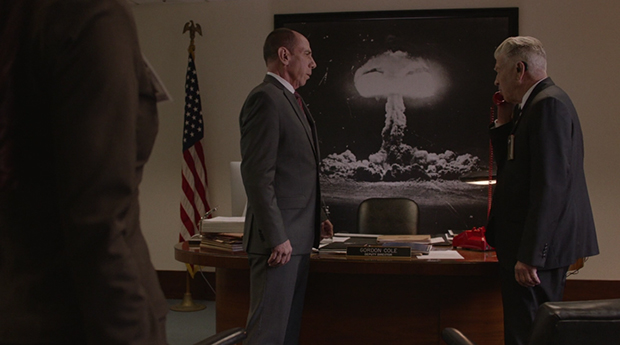
Manhattan Project nuclear test, Trinity, July 16,
1945.
This is an image of the Manhattan Project nuclear test, Trinity, on July 16, 1945.
The atom blast mushroom cloud has been with us from near
the beginning in Lynch's work, it appearing in Eraserhead, in the
apartment of the anxiety-beleaguered Henry.
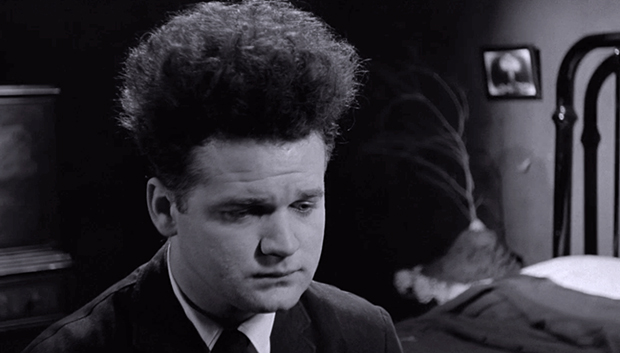
The atom bomb and the barren tree in
Eraserhead.
Oppenheimer named the blast "Trinity" in reference to John Donne's "Batter my heart, three-person'd God" from his Holy Sonnets.
Batter my heart, three-person'd God, for you
As yet but knock, breathe, shine, and seek to mend;
That I may rise and stand, o'erthrow me, and bend
Your force to break, blow, burn, and make me new.
I, like an usurp'd town to another due,
Labor to admit you, but oh, to no end;
Reason, your viceroy in me, me should defend,
But is captiv'd, and proves weak or untrue.
Yet dearly I love you, and would be lov'd fain,
But am betroth'd unto your enemy;
Divorce me, untie or break that knot again,
Take me to you, imprison me, for I,
Except you enthrall me, never shall be free,
Nor ever chaste, except you ravish me.
Oppenheimer also drew quotes from the Bhagavad-Gita in his thinking on the bomb. From Wired:
Oppenheimer, watching the fireball of the Trinity nuclear test, turned to Hinduism. While he never became a Hindu in the devotional sense, Oppenheimer found it a useful philosophy to structure his life around. "He was obviously very attracted to this philosophy," says Rev Dr Stephen Thompson, who holds a PhD in Sanskrit grammar and is currently reading a DPhil at Oxford University on other aspects of the language and Hindu faith. Oppenheimer's interest in Hinduism was about more than a soundbite, it was a way of making sense of his actions.
The Bhagavad-Gita is 700-verse Hindu scripture, written in Sanskrit, that centres on a dialogue between a great warrior prince called Arjuna and his charioteer Lord Krishna, an incarnation of Vishnu. Facing an opposing army containing his friends and relatives, Arjuna is torn. But Krishna teaches him about a higher philosophy that will enable him to carry out his duties as a warrior irrespective of his personal concerns. This is known as the dharma, or holy duty. It is one of the four key lessons of the Bhagavad-Gita: desire or lust; wealth; the desire for righteousness or dharma; and the final state of total liberation, or moksha.
Seeking his counsel, Arjuna asks Krishna to reveal his universal form. Krishna obliges, and in verse twelve of the Gita he manifests as a sublime, terrifying being of many mouths and eyes. It is this moment that entered Oppenheimer's mind in July 1945. "If the radiance of a thousand suns were to burst at once into the sky, that would be like the splendour of the mighty one," was Oppenheimer's translation of that moment in the desert of New Mexico.
In Hinduism, which has a non-linear concept of time, the great god is not only involved in the creation, but also the dissolution. In verse thirty-two, Krishna speaks the line brought to global attention by Oppenheimer. "The quotation 'Now I am become death, the destroyer of worlds', is literally the world-destroying time," explains Thompson, adding that Oppenheimer's Sanskrit teacher chose to translate "world-destroying time" as "death", a common interpretation. Its meaning is simple: irrespective of what Arjuna does, everything is in the hands of the divine.
"Arjuna is a soldier, he has a duty to fight. Krishna not Arjuna will determine who lives and who dies and Arjuna should neither mourn nor rejoice over what fate has in store, but should be sublimely unattached to such results," says Thompson. "And ultimately the most important thing is he should be devoted to Krishna. His faith will save Arjuna's soul." But Oppenheimer, seemingly, was never able to achieve this peace. "In some sort of crude sense which no vulgarity, no humour, no overstatements can quite extinguish," he said two years after the Trinity explosion, "the physicists have known sin; and this is a knowledge which they cannot lose."
The way it was expressed to Albert and Gordon, the viewer is given to expect that the Cooper is himself on the line. We know that Cooper-Dougie won't be calling, so we suppose it will be Mr. C calling from prison? Even Albert expects Cooper to be on the phone.
GORDON: This is Cole. Yes, I'll hold.
ALBERT: Is
it him?
GORDON: What?
ALBERT (yells): Is it him?!
GORDON
(into the phone): Yes, I hear you. (29) Tammy, and behind her a portrait of Kafka. (30) Albert and Gordon. GORDON: What? Where? Are you sure it's him? (31) Tammy. (32) Albert and Gordon. GORDON:
What do you mean "trouble"? All right, we'll be out there first thing
tomorrow morning. Set up an interview for nine o'clock sharp. (He hangs
up. When he does so an airy hum sound stops.) Albert, we're headed for the Black Hills of South Dakota. (33) Tammy.
(34) ALBERT: The Black Hills? Seriously?
GORDON: As happy as this news
makes us, Albert, we can't put this on the radio.
ALBERT: Perfect.
I've been dying to see Mount Rushmore.
Gordon (knocking the desk):
It's good you want to hurry. We fly at dawn, and, Tammy, you're coming
with us.
(35) Tammy. (36) Gordon exits.
(37) Albert.
ALBERT (to Tammy): The absurd mystery
of the strange forces of existence. (38) Tammy. (39) Albert before Gordon's desk. ALBERT: How about a truckload full of
Valium? (40) Tammy.
Gordon has, as in the original series, his hearing difficulties that create
double conversations and encourage the viewer to look for word play.
The first appearance of Gordon in Fire Walk with Me had him also inviting
the viewer (and FBI agents) to look for hidden meanings in the character
of Lil, her attire and mannerisms all discretely commenting on a situation. Lil also wore a blue rose on her dress. Though the blue
rose has to do with unsolved cases of a paranormal nature, it's easy to
see how the "blue rose" could, via the symbolic language often seen in
those cases, stand simply itself as a symbol for the hidden.
The "seriously" is word play to do with Sirius satellite rado, but it also refers back to The Secret History. In The Secret History is a record (fictitious) of Douglas Milford interviewing the real life rocket scientist and occultist Jack Parsons. Parsons was talking about aliens, messengers of the gods, having visited earth. "The desert's a perfect medium for summoning--an empty canvas...you can create an elixir that will call forth--call them what you will--messengers of the gods." He had spoken of the "tall ones", Nordic types, benign, that supposedly come from the Dog Star. Milford had noted Parson's eyes took on a glassy sheen and he had wondered if he was on drugs. He had asked, "The dog star?" Parsons had replied, "Serious." Milford had said, "Yes, I'm serious", and Parsons had laughed, the reason for which had escaped Milford. Parsons had then asked Milford if he had ever been to Roswell and spoke of being at Jornada del Muerto (Journey of the Dead Man) near White Sands.
When Parsons had said, "Serious", he was actually saying, "Sirius". Which is the name of the Dog Star.
When Albert says, "The Black Hills? Seriously?" and Gordon responds, "We can't put this on the radio", we are to think not only of satellite radio but the conversation between Milford and Parsons, in which Parsons had spoken not only of Sirius but Jornada Del Muerto, which is just west of Ground Zero of Trinity, and we see the image of that blast behind Albert and Gordon.
This is followed by the word play concerning Mount Rushmore, Gordon telling Albert that it's good he wants to hurry (rush more) after Albert had facetiously said, "I'm dying to see Mount Rushmore." Gordon has superstitiously knocked on wood because of Albert's joke concerning his own death. There are many variations on the reason for knocking on wood, often to prevent the evil eye and ward off bad luck, but that "I'm dying" refers back to Jornada Del Muerto.
Opposite the Trinity photo is the portrait of Franz Kafka, and we only see this in connection with Tammy. Albert and Gordon are shown before Trinity while Tammy is shown before Kafka.
The other reference to Kafka, and presumably his metamorphoses, was back at the
Hastings house in part one, a different portrait of Kafka glimpsed in the
foyer. We view it in the image below in conjunction with the wolf's head door knocker, just as here we have the image of Kafka and Gordon knocking on the wood of the desk to ward off bad luck.
That portrait was scarcely noticed, while this one
stands out boldly, Kafka magnified and staring the viewer down.
Because two portraits of Kafka are involved, I'm going to go with the significance of this bringing in again the idea of doubling, twinship, "Tammy" meaning twin, the female version of Thomas. We have, after all, just seen a woman bearing her likeness in one of the photos concerned with the case of the congressman.
With the FBI, we have the return of the two beloved characters of Gordon
and Albert, due the doppelganger being picked up and identified as
Cooper. We also have this new character, Tammy Preston, who has been
investigating the murders in New York. We are not given any resolution
concerning those murders, but the viewer now at least has the return of the FBI. Yhe FBI being aware of
the incident in New York, and becoming aware of doppelganger-Cooper's
surfacing in South Dakota, is comforting and reassuring to the
viewer, pushing the story along. They expect the FBI to do something
about these things and that they will learn more about them through the
FBI's investigation. Certainly, Gordon and Albert will realize that the doppel isn't the Cooper they knew!
THE ROADHOUSE
An upside down reflection of the Bang/Bang neon in rain water. The band, The Cactus Blossoms, plays "Mississippi".
Some word play. Think what's missing.
The episode was dedicated to Don S. Davis (Major Briggs) and Miguel Ferrer (Albert).
Some notes on the origin of David Lynch's garmonbozia (the creamed corn of pain and suffering) and arm/mother/tree relationship in Eraserhead
At the beginning of Eraserhead a thing emerges from Henry
Spencer's mouth that is so similar to the creature he is later given to
have fathered that this must be regarded as its inception. We've no hint
of a pregnancy. The child-thing is simply suddenly there, in the
hospital, the mother's mother announcing its presence, and Henry Spencer
faced with responsibility for its life and care. Though I've read that Lynch's daughter
has said the child has a good deal to do with her unexpected conception,
and physical problems with which she was born that needed surgery, and
individuals joke that central to Eraserhead is a fear of
parenthood, this
"child" can be understood as representing Henry himself, or he at least comes to see himself in
its place, the expression of a terrifying bundle of implacable
anxieties. The role of the mother is scarcely present, and she ultimately abandons the child to Henry, unable to
deal with it.
We have in Eraserhead a connection forged between the arm, the
tree, and "mother" that is found also in Twin Peaks. In
Eraserhead, Henry is invited to dinner with the parents of his
girlfriend. When they sit down to a platter of small "man-made" Cornish
hens, for no obvious reason the girl's father relates how he'd had
surgery on his left arm and was told he would never be able to use it
again. With time, rubbing it for a half hour daily, he was able to
regain function, but the arm is now numb. He hits it and feels nothing.
He says he's afraid to "cut it" and what he means is ambiguous. We are
unsure if he is talking about the arm or the Cornish hens. Then he
states that Mary, his wife, usually does the carving and asks Henry to
take the responsibility instead. When Henry hesitantly puts a fork in a
Cornish hen, blood pours from its body cavity, from between its legs,
reminding of perhaps a woman's period or giving birth. It is after this
that Henry is informed by the girl's mother that he is now a father.
The numbness of that arm is characteristic in Twin
Peaks of the arm of individuals who wear the green ring. For
instance, Dougie's arm becomes numb before he vomits up the garmonbozia
and finds himself in the red room with the zigzag floor.
That zigzag floor is another thing that first appears in
Eraserhead, the entry area of Henry's apartment building having
a floor with the same pattern.
To continue, we have already
seen beside Henry's bed a small defoliated tree. Toward the end of the
film, when Henry is on a dream stage with its checkered floor, before
theatrical stage curtains as are seen in Twin Peaks' Red Room, a larger
version of this tree is rolled out on a sculptural representation of a
mound of earth. Henry's head pops off and blood pours from the soil
beneath the tree to surround the head on the floor. But as the film is
in black and white the blood looks black, just as it did when pouring
from between the Cornish bird's legs. A link is forged between the tree
and the arm as both lead to an effluence of blood. The black liquid
becomes a gate of sorts, Henry's head dropping through it to what
appears to be his "real" world. In this way the black liquid that pours
from the sculptured soil is like the black oil, surrounded by the
denuded sycamore trees, that is a mystical gateway to the black lodge in Glastonbury Grove.
Henry's head, carried by a young boy, eventually makes it to a pencil
factory where his brain becomes the rubber for pencil erasers.
What was missing from the earlier Cornish hen was, of course, the head
and all the organs from the emptied body cavity. The "child" is
represented as not much more than a head attached to a swaddled form,
this swaddling resembling the wrapping of tree roots in burlap. Henry
did not carve the Cornish hen, but in the film he finally "carves" the
child by cutting open the swaddling that turns out to be a vessel for
the child's organs. A substance reminiscent of the garmonbozia of Twin
Peaks floods out of these organs. Garmonbozia, which is pain and
suffering, is given as having the texture of creamed corn. One can see
how this "corn" would have a relationship to the Corn-ish hen. It may
even be that the word Garmonbozia derives from garbanzo beans, which are
"chick peas", and ambrosia, the food/drink of the gods which conferred
immortality or longevity.
In Twin Peaks Lynch has resurrected many of these idea. In the Red Room's
defoliated tree, which is stated as an evolution of the "arm", we have not not only the dead tree in Eraserhead, but the tree has a head
that is not exactly the same but is decidedly reminiscent of the child
in Eraserhead.
A characteristic of the "child" in
Eraserhead was that it refused to eat, which was a great source
of frustration. It also seemed to never sleep. And yet, when its
swaddling was cut open and its organs laid bare, the substance that is
later garmonbozia in Twin Peaks flows from it. One could look
at this anxiety "child" as having fed on the pain and suffering it was
causing. Though one feels sympathy for it, the anxiety "child" has been
nourishing itself on the pain it causes. However, we know from Henry's
dream, when his head pops off, that the child's head is his own. The
pain and suffering seem to be both from him as well as being his
nourishment.
STAB AT A TIMELINE
A timeline as best as can be reasoned on information
given thus far:
PART ONE:
1. Supernatural - B&W room
2. Jacoby's trailer,
day - Wednesday?
3. New York, Sam and Tracey, after 10 at night -
Wednesday
4. The Great Northern Lodge, Ben and Jerry, day -
Thursday
5. Twin Peaks Sheriff's Department, Lucy and the insurance
agent, day - Thursday
6. Buella's, night - Thursday
7. New York,
2nd night (we know this is certain) - Thursday
8. Buckhorn, South
Dakota, discovery of Ruth, day - Friday
9. Twin Peaks, Margaret
calls Hawk at work, night - Friday
10. Buckhorn, the coroner's, day
- Saturday
11. Buckhorn, Hastings taken into custody, day -
Saturday
12. Twin Peaks, Hawk, Lucy and Andy in the conference room,
day - Saturday. (Lucy wears the same clothes as in the scene with the
insurance salesman, but this scene and that one are separated by at
least one night in Twin Peaks. Hawk had spoken with Margaret at night, at
the office, but this scene is in daylight and so is another day.)
13. Buckhorn, Hastings interrogated - Saturday
14. Buckhorn,
Hastings home searched - Saturday
15. Supernatural - B&W room.
PART TWO
1. Buckhorn, Phyllis visits Bill in jail -- Saturday (Bill was picked up
on Saturday, presumably)
2. Buckhorn, Mr. C kills Phyllis --
Saturday night
3. Las Vegas, Duncan and Roger in Las Vegas, a woman
is given a job -- Saturday night
4. Buckhorn, Darya, Ray, Jack and
Mr. C eat at the motel's diner -- Saturday night
5. Twin Peaks, Hawk
visits Glastonbury Grove - Saturday night
6. Laura disappears from
the Red Room -- Undetermined time but perhaps equivalent to Saturday
night in real time
7. Buckhorn, Jack and Mr. C hide the Mercedes,
Ray lands in prison -- Sunday
8. Buckhorn, Jack and Darya killed by
Mr. C -- Sunday
9. Supernatural, Cooper looks out on Mr. C driving
the car -- Monday (as far as Mr. C goes)
10. New York, Cooper drops
into the New York box -- Fall back to NY Thursday
11. Twin Peaks,
Sarah Palmer watches television -- Undetermined time, can't be stated
with any confidence right now due to Cooper's slipping into Thursday and
then being swept out into space again. Perhaps Thursday.
12. Twin
Peaks, Shelly and James are seen at The Bang Bang -- Undetermined time,
can't be stated with any confidence right now due to Cooper's slipping
into Thursday and then being swept out into space again. Perhaps
Thursday.
PART THREE
1. Cooper falls through space, spends time with Naida and American Girl,
then takes Dougie's place. The American Girl's watch seems to read
Saturday the first. Frost's The Secret History of Twin Peaks is
based on a dossier of events relevant to Twin Peaks that is being
researched by Tammy Preston in August of 2016, and which is finally
determined to have been put together by Major Briggs. Saturday falls on
a 1st on 2/1/2014, 3/1/2014, 11/1/2014, 8/1/2015 and 10/1/2016. If this
is 2016 then this Saturday the 1st that was on the American Girl's watch
would likely have to be October 1st of 2016--but in the otherworldly
space who's to say what year it is? SA could instead refer to Saturn
(and perhaps does as well). If the date is Saturday the first, we still
have Mr. C driving down the highway on, according to prior events, what
should/could be a Monday. Right now we would take it for granted that
Dougie is replaced by Cooper during the same time frame, on Monday,
though it may be Saturday, October the 1st in this room with the
American Girl. - Monday (as well as perhaps Saturday October 1st)
2.
Buckhorn, Mr. C found on the highway - Monday
3. Twin Peaks
Sheriff's Dept bunnies. Perhaps this is Monday. - Monday
4. Twin
Peaks, Jacoby's shovels. Also perhaps Monday. - Monday
5. Las Vegas,
Back to Vegas and the Silver Mustang Casino, this occurring on the same
day that Cooper replaces Dougie. - Monday
6. Philadelphia, The FBI
meeting at sunset. - Monday
7. Twin Peaks, The band at the Roadhouse
would be a night scene. Just based on all previous shots in this episode
being during the day, I will go with this being Monday night. -
Monday
Approx 21,700 words or 44 single-spaced pages. A 166 minute read at 130 wpm.
Prior: Go to Part 2
Next: Go to Part 4
Go to Table of Contents for Analysis of Twin Peaks Return
Link to the main TOC page for all the analyses

